






















Hey there! I’m Jeannine Cintron, the new Editorial Director at New York Family, stepping in for Donna as she moves onto a wonderful new chapter in her life. While this marks the start of a new chapter for New York Family as well, I plan to continue providing your family with all the best events, activities, resources, tips and advice that parents need to raise happy and healthy children in Long Island as we always have.
A bit about me: I’m a proud lifelong New Yorker! I’m also a perpetually overcaffeinated single mom to a 16-year-old boy and a 12-year-old girl who keep my heart young and my hair grey. I also have three cats because cats make everything better (just ask any NYC bodega owner).
It seems fitting that my first issue in this new role is a Back-to-School one. A new school year is all about new beginnings and fresh starts, a chance to set new goals and work even harder toward old ones. While some kids look forward to this, picking out their first-day outfits a month ahead of time and daydreaming about seeing old friends again, others are a lot less enthusiastic. Easing Kids Into Back-to-School Mode (page 6) offers tips on everything from routines to building social connections.
When kids head back to school, they also go back to afterschool activities. Now is the time to sign your child up for sports, theater, STEM, dance, gymnastics, music and any other enrichment programs they might be interested in. In the Ultimate Guide to Afterschool Programs and Activities, we not only share the many benefits of these

programs (page 10) but we also help you find the right one for your child (page 11).
I always say summer’s end is bittersweet, since it marks the start of fall, the cinnamon spiciest season of them all. We’re sharing our favorite apple orchards (page 26) so that you can enjoy a fun family day at the farm, then get started transitioning to that fabulous autumn decor you’ve been itching to take out since July.
Wishing you all an exciting and successful school year!
Jeannine
Share your feedback and ideas about family life in New York!
Email us at editorial@newyorkfamily.com and tag us at #newyorkfamily
p ubli SH er: Clifford Luster
editorial director: Jeannine Cintron
aSSociate p ubli SH er: Erin Brof
adverti S ing d irector: Stacie Goldberg
editor-at-large: Donna Duarte-Ladd
e vent S manager: Shara Levine
Senior d igital e ditor: Thalia Fernandez
digital editor: Marina Dunbar
e ditorial aSS i S tant: Alexa Lutter
partner SH ip manager S : Lauren Alperin, Lauren Anchin, Joan Bergman, Mary Cassidy, Suzanne Cirigliano, Chris Cunnington, Lori Falco, Shelli Goldberg-Peck, LynnMarie Hanley, Lisa Herlihy, Nicole Miller, Janine Mulé, Nina Spiegelman, Gwen Tomaselli
marketing & Strategy d irector: Rosalia Bobé
marketing & e vent S aSS i S tant: Ashley Rivera
Sale S & marketing a SS i S tant: Elana Cantor
marketing aSS i S tant: Tilejah Gilead
m edia Sale S aSS i S tant: Anastasia Aktipis
art d irector: Leah Mitch
Web d eveloper: Sylvan Migdal
g rap H ic d e S igner S : Arthur Arutyunov, Connie Sulsenti
e ditor at large: Cris Pearlstein
e ditorial contributor S : Jana Beauchamp, Mia Salas
e ditorial intern: Avital Kessner
contact information
adverti S ing : (718) 260-4554
Advertising@NewYorkFamily.com circulation: (718) 260-8336
Tina@NewYorkFamily.com
addre SS : New York Family Media/Schneps Media 15 MetroTech Center, Seventh Floor Brooklyn, NY 11201
p re S ident: Victoria Schneps-Yunis
ceo : Joshua Schneps
coo : Clifford Luster

















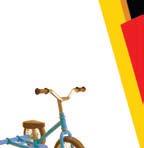



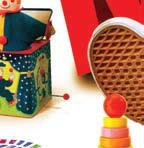















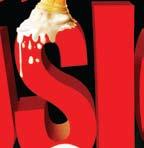





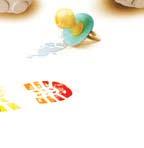






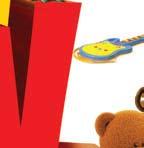








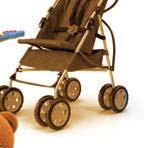








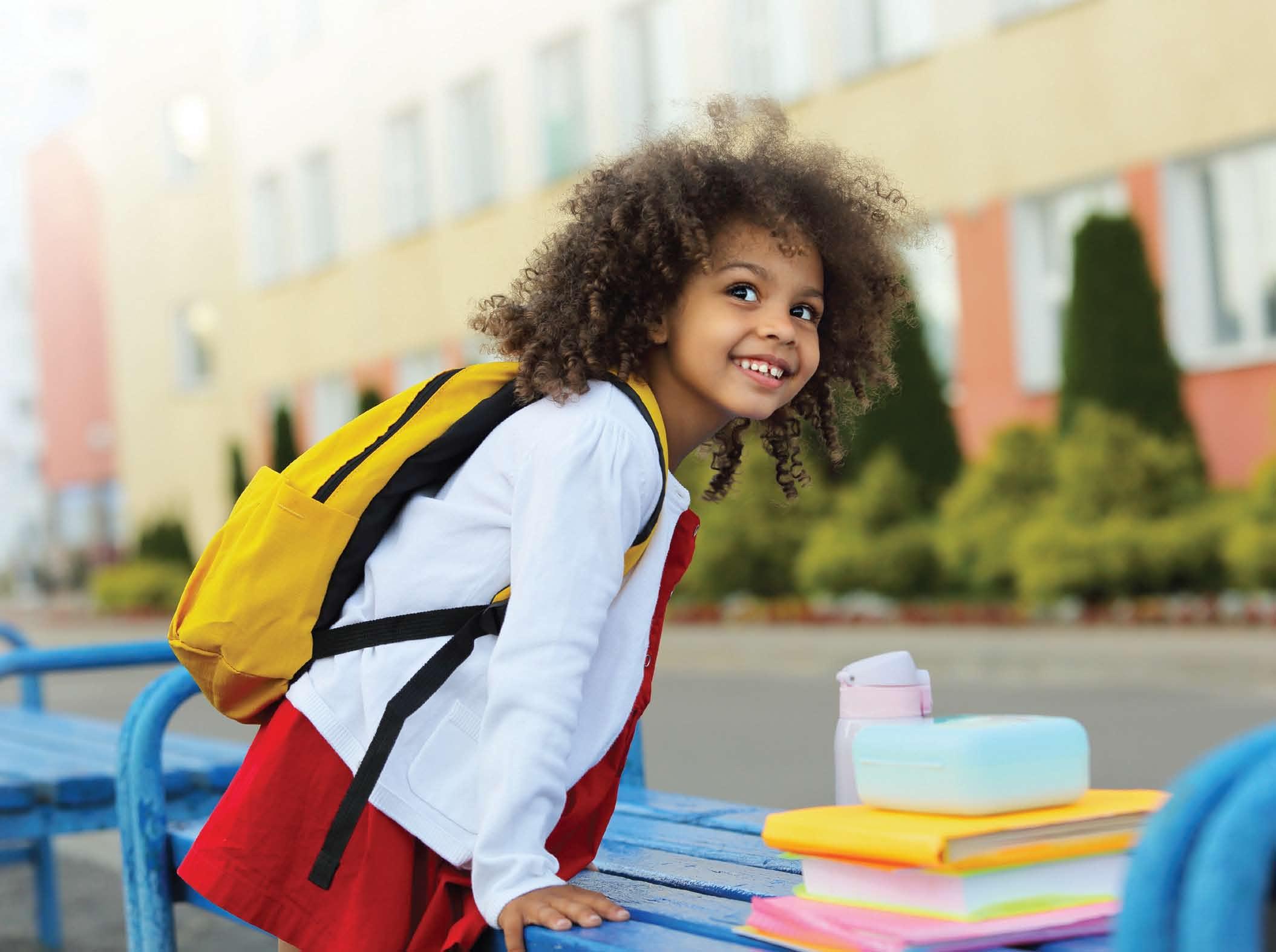
By Rosdaly RamiRez
Do you remember what you felt leading up to the first day of school as a kid? I can recall the before-sleep thoughts, the morning excitement and worries that came with the idea of heading back to school. If you have little ones, their behaviors may look about the same: more tears than usual, some may find comfort in clingy to your leg, and others may have a sudden burst of joy. After working with children for many years and spending five of those years working with high school students, transitioning back to school for kids is a huge milestone. Transitions can bring up a lot of emotions and behaviors, and if you’re a parent, preparing your child for them sets them up for how these big milestones will impact them. Here are some key pieces of advice I have for parents as a social worker and parent of three kids:
Before School StartS :
Establish a Routine
Begin a consistent bedtime and morning routine a few weeks before school starts. This will allow your child to mentally and physically start adjusting from the summer routine
to the new school year. If you have little ones, pictures are a great way to help your child identify what their daily life will look like.
with the School Environment
Visit the school together to explore the classroom, playground, and other key areas. This is very important for all kids; it builds up their imagination, which can lead to conversations with you. If you have a child with sensory disabilities that thrives off routine, it’s especially important for them. Attend any orientation sessions or meet-and-greet events with teachers. Your child’s teacher is another adult who will play a role in your child’s life. Safety is a big thing for kids, and getting the opportunity to know them can really set the tone for how they transition into the classroom.
Talk about the exciting aspects of school, such as making new friends and learning new things. Ask questions. Dinner time is a great place to have these conversations. I always invite parents to share some first-day school stories.
For little ones, read books about starting school to build anticipation and reduce anxiety.
Practice Independence
Encourage self-help skills like dressing, using the bathroom, and opening lunch containers. Assign simple tasks at home to boost their confidence in handling responsibilities.
Your attitude can significantly influence your child’s feelings. Stay positive and calm. Your attitude affects your children’s mornings, and it spills over to the rest of their day.
Just like it’s their first big day, it’s also yours. Have a check-in with yourself. Write down some worries you may have or emotions that are coming up for you. Be prepared to navigate different emotions that morning, so get rest and also have a routine for yourself.
Create a Goodbye Ritual
Develop a consistent, quick, and positive goodbye routine. You know your child best; what will comfort them as you say goodbye?
If you have little ones, I highly
recommend getting them a comfort item. Each year, I give my son a soft heart. He takes one to school, and I keep one with me. It comforts him to know we’re connected, though I’m not with him.
Encourage Social Connections:
Some kids thrive in seeking out relationships, while others may have anxiety even thinking about it. Making connections as kids get older can be hard, so encourage your kid from a lens of empathy and space.
After the pandemic, we’ve seen an increase in social anxiety, though as parents we want to encourage social connections. I would recommend that if you sense your child is feeling anxious, have a teacher, counselor, or social worker check in with them at school.
Addressing Emotional Needs: Acknowledge Feelings
Listen to your child’s concerns and validate their feelings.
Provide comfort and understanding without dismissing their worries.
Promote Problem-Solving
Encourage your child to think of solutions to any challenges they face.
Role-play different scenarios they might encounter at school.
Stay Involved
Maintain regular communication with teachers and school staff. Your child’s teacher is on your team, So communicate changes in your child, things you’re noticing about them or when big changes are happening in your family. They all impact your child’s behavior in school. It also leaves an open door for teachers to do the same.
Participate in school activities and volunteer opportunities to stay connected with your child’s school experience. As your child gets older, this will be important. I know they may be in a stage where you’re “ embarrassing,” but showing up to activities they’re participating in builds your confidence and relationship with them.
After School StArtS
Establish a Post-School Routine: Create a calming routine after school to help

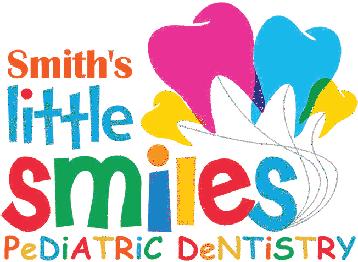
your child unwind and share their day. The first hour back home should be a time when they get to choose what they want to do. It’s also an important time for you to disconnect from work and other responsibilities to make room for your child to connect with you.
Monitor Progress:
Keep an eye on your child’s academic and social progress.
Address any concerns promptly with teachers or school counselors/ social workers..
Celebrate Milestones:
Acknowledge and celebrate your child’s achievements, both big and small.
Provide positive reinforcement and encouragement regularly.
I hope these tips will help you begin transitioning into the school year as you support your child for another exciting year this Fall. And remember, you’re learning just as much as they are about navigating parenthood. Have some grace with yourself.

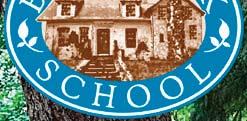
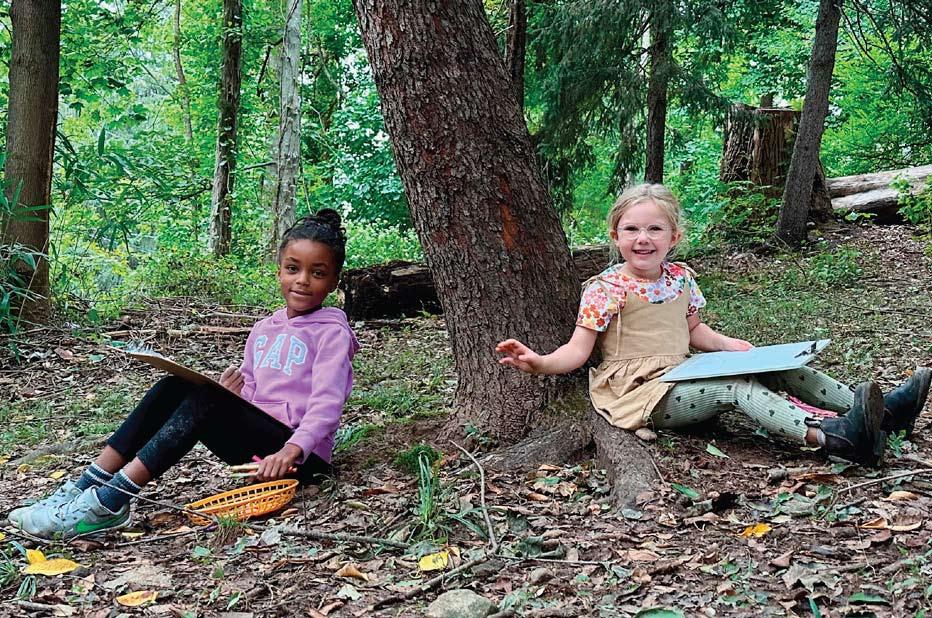
Saturday, October 19th, 10am to noon
Four and five year olds are invited to visit for a morning of storytelling, crafts, and play while parents learn about our progressive approach to education infused with the arts, nature, and imagination. Attendance is limited, please RSVP
By BarBara russo
Enjoying a healthy, delicious lunch is important at any age. While it can be challenging to come up with new lunch ideas for your kids, preparing healthy school lunches can be done with ease while providing tasty and nutritious menu options. There are so many things that are critical for a productive school day for your child—and having a good lunch is one of them. In fact, according to the Food Research & Action Center (frag.org), school meals play a critical role in student health, well being and academic success.
While school-provided meals are an option, you can also send your child to school with a power-packed lunch to help boost their learning and keep their energy up throughout the day. Preparing healthy school lunches can be fun, and it’s something you and your child can do together. Here are some tips you can keep in mind while creating your fabulous and healthy lunches:
Mix and match food options
According to the National Education Association, the important thing to remember when making lunches is to offer a wide variety of options to your child. Try different dips for different veggies, swap out the usual sandwich bread for a wrap, pita or whole grain bun.
Consider gut health
Maintaining a healthy microbiome can prevent or lessen the effects of gut-related issues like allergies, E. Coli infection, asthma, skin issues and other conditions, explained gastroenterologist, Rajesh Dhirmalani, D.O.
“A healthy diet, hydration and building good bacteria in the gut through supplements and probiotics like Flore

Clinical play a crucial role in kids’ gut health,” the doctor said.
Include these foods:
Think high-fiber fruits and vegetables when preparing healthy school lunches. Keep the skin on to help aid digestion and promote good bacteria. Apples, raspberries, broccoli, and snap peas are easy additions to make your child’s lunch healthier.
“Berries and tomatoes are high in antioxidants, and oats, beans and chickpeas are good sources of proteins, vitamins, and minerals,” Dhirmalani said. “Avoiding processed and artificially or overly sweetened foods is also essential, as they contribute to the overgrowth of bad bacteria in the gut.”
Try bento boxes
They’re very practical for preparing healthy school lunches. Bonnie Lak, a mom from New Jersey, has a teen who loves using the Takenaka bento box.
“Alexandria likes to eat healthy, so she likes to pack it with little cucumbers, fresh fruit, tomatoes, strawberries and blueberries,” Lak said.
Pick good protein
On the subject of protein when preparing healthy school lunches, Dhirmalani recommends reducing red meats to once a week or less.
“Fresh vegetables and healthy fiber like beans, lentils and chickpeas should be included as often as possible,” he said. “Adding fresh herbs and spices is a quick addition and has a long list of health benefits.”
Consider dental health
Joe Albanese, DMD, of Marine Dental Services, recommends steering clear of any hard-to-swallow gummy candies or overloading on dried fruit, which can get stuck in teeth.
“Although dried fruit is a healthier alternative to candy, it still contains a lot of sugar and can cause cavities if the teeth are not properly brushed and flossed after eating it,” he said, adding that calcium-rich foods like cheese and yogurt are great for strong teeth.
Fun fact: Strawberries contain malic acid which helps keep the teeth stain-free and white. Who says all sweets are bad for your teeth?
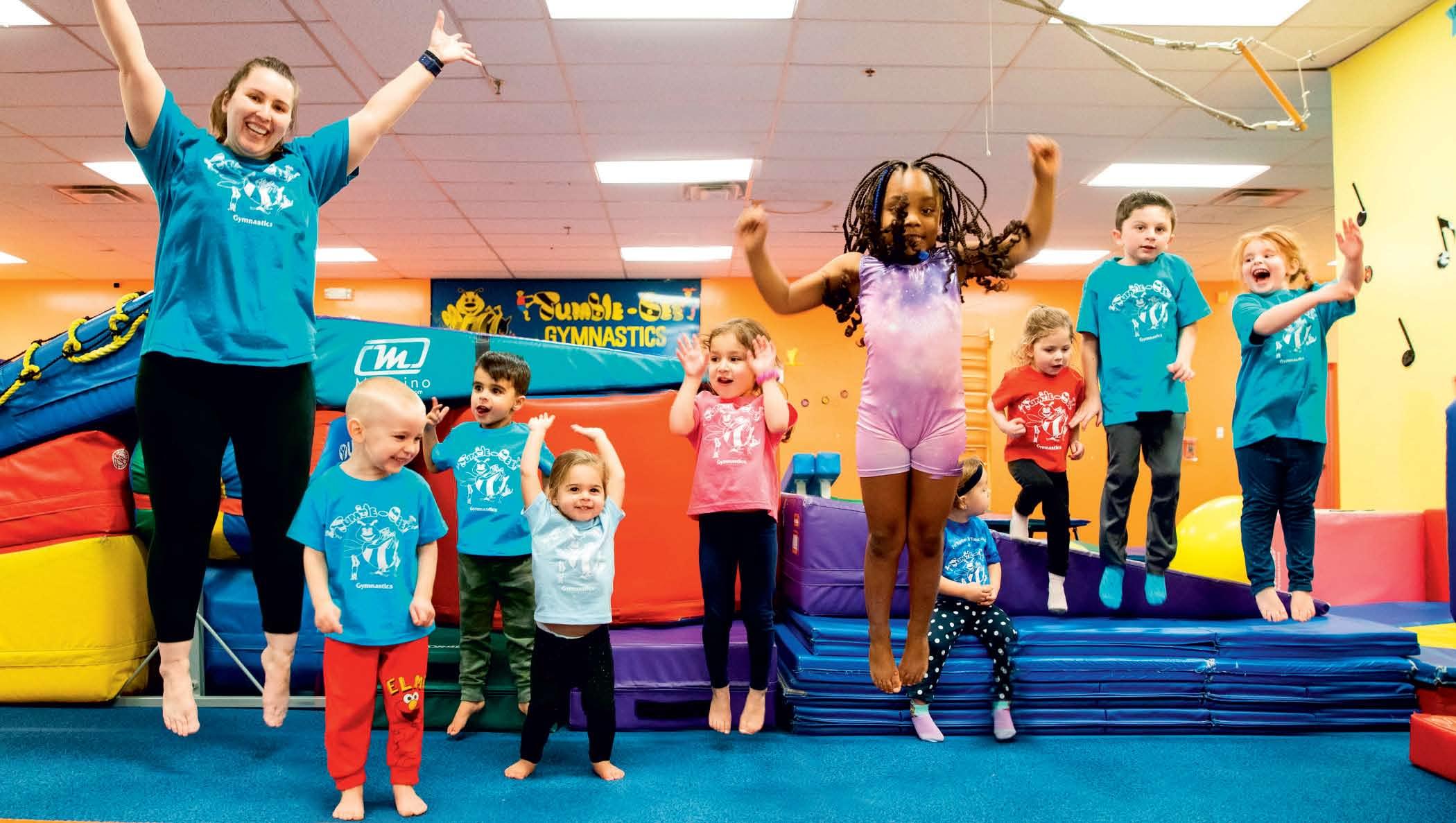


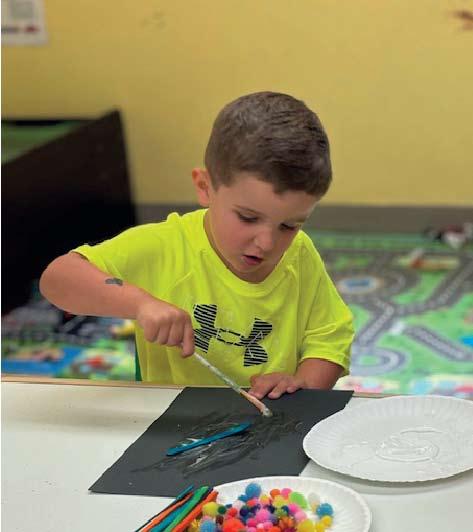
By Serena norr
According to the Afterschool Alliance, kids spend more than 1,200 hours in school every year. While that may seem like a substantial amount of time, school only accounts for 20% of a child’s time. This is why after-school programs and activities are a big part of our kids’ school experience. Programs and activities are essential in fostering social and emotional growth, just as important as academic reasons. For busy parents, particularly those juggling work commitments (#iykyk), these programs provide a space where children can thrive safely and productively, extending the learning and joy beyond the regular school hours.
Read on to discover more about why after-school programs are so beneficial to kids and their families.
Meet New Friends
After-school classes allow kids to connect and meet new people outside of school. Extracurricular activities help form a community and forge a sense of belonging as they hyper-focus on one activity. This can also benefit students who struggle with making friends in school, where they can connect with a different set of peers in smaller groups.
Encourages Physical Activity
After-school activities, like sports, encourage kids to participate in teamwork as well as offer physical activity, help with stress, may improve self-esteem, foster healthy habits, and may promote mental well-being. Kids who participate in sports may also forge longterm bonds that they participate in until the end of high school.
Many schools have limited programming within music and the arts. After-school programming allows kids to try these

programs and express themselves in a new way through acting, music, and/or learning a new artistic skill. They can also help unleash creativity, improve communication, boost confidence, and improve focus and concentration.
After-school activities are fun and offer a way for kids to do something exciting and engaging beyond their typical school day. This can be a release for students with a rigorous and intense course load and schedule.
Here in New York, we have some of the best after-school programs in the country. Participating in an after-school program allows kids to thrive in a safe and supervised environment until a parent or guardian can pick them up.
Provides a Safe and Supportive Environment
After-school programs provide a safe space during times when some kids might be unsupervised. Under an instructor’s guidance, kids develop new skills and learn from a mentor/teacher who can help kids foster new passions/interests. According to the National Conference of State Legislatures, “regular participation in an after-school program may also reduce risky behaviors and help kids gain college and career-needed skills.”
A supportive after-school program provides a well-rounded educational experience that can impact other aspects of school, such as improved concentration, reduced behavioral problems, and fostering new passions, helping lift kids’ moods and well-being.
By Stacey eBert
As a kid, I loved after-school extracurricular classes. Whether summer camp, gymnastics, or high school clubs –regardless of the time of year- I embraced the energy that came with all activities. As a young adult, I led youth groups, ran after-school classes at the local community center, and taught many kids to swim. I felt lucky to have teachers and counselors who chose to share their time, energy, expertise, and talents.
As the kids return to school, it’s time to ensure those young minds have extracurricular classes, activities, or sports to engage, foster, and energize their spirits. Parents should know something exists for all kids – it might take time, effort, trial and error, thinking outside the box, recruiting experts, and listening to your child’s voice. It might mean investments in energy, money, community, and heart. However long it takes to find the thing that lights them up – it’s worth it.
Here are four tips to help find an engaging extracurricular class or activity for your child.
Listen actively to the kind of activity , class your child needs Kids have a way of sharing their thoughts. Young children might not have the words yet, but they know how they feel. Those with the words might not have the meaning flushed out, and some kids may be shy and might need coaxing to try something new. Listen to what seems to interest them and provide options, give them the tools to research, keep an open line of communication, remind them they’ve got a support system, encourage giving it a try, and help them see that the nervous excitement of expanding that comfort zone is worth both the risk and joy.
Know what sorts of classes, sports your child gravitates towards There is something for everyone in New
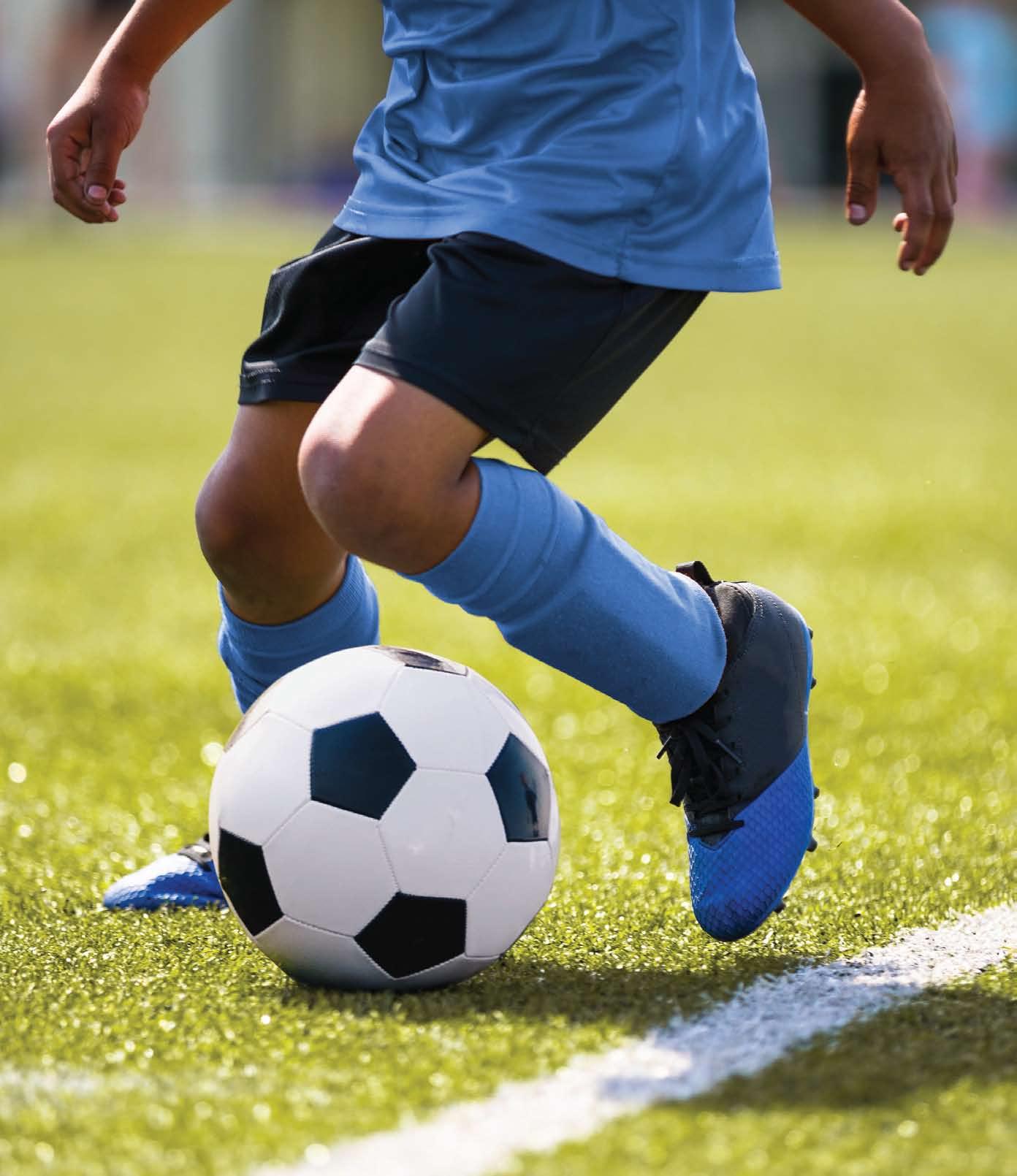
York – offering many enriching activities encompassing diverse arts, including painting, sculpting, dancing, drawing, poetry, writing, music, theater, and more. Engaging in the arts fosters talent and expands your child’s understanding of the world, nurturing a heightened sense of selfawareness. For those passionate about sports, tailor-made winter classes are available after school or on weekends, providing the ideal outlet for children to expend their boundless energy.
Don’t overextend your child’s extracurricular schedule
Parent tip: If you’re overextended, your child is overscheduled, or your child (or you!) is about to experience sensory overload, then less is more. One meaningful activity is more than enough.
If one day a week or a few hours each is sufficient, it will work for your child and, most importantly, the family.
There is an activity, class, or sport out there for every child
In families with more than one kid, you may
run around and do different activities for your children, as only all of your kids will want to do the same sport or class.
So, lead them to what they will thrive in or take a mild interest and turn it into a fullon hobby.
For example, If your child has an ear for languages, steer them towards an international culture or language club. If they’re pulled towards teams, leadership, and exercise, see what types of sports or club teams are out there for them. If they crave connection and want to learn creative pursuits, consider opening their world towards what’s possible in arts, community service, or learning something new. They want to practice swimming midwinter, there’s a club for that. They want to learn chess and build their interpersonal skills simultaneously; there’s a class for that. They want to learn marketing, debate, and business skills – there’s an organization for that. They want to learn survival skills and embrace the goals of scouts and leadership; there’s a space for that.
Give them a safe, non-judgemental space to share their interests and thrive.


It’s no secret that education is a vital part of any child’s development; that’s why school is a requirement. But what about the experiences and lessons they learn when school is out? Academics are important, but enrichment comes in many forms. A child is often likely to discover hidden talents or new interests through afterschool activities, so it’s highly recommended that parents enroll their kids in a multitude of extracurricular programs like dance, music, theater, sports, etc. to see where they will shine! With back to school right around the corner, now is the time to decide which programs best suit your child. Here in New York, the options seem endless, so we narrowed it down with these top afterschool programs in Rockland. Each program is expertly crafted by top-tier professionals, ensuring that every child reaches their full potential while having fun at the same time. Check them out below!

Bright Beginnings of Rockland
60 E. Madison Ave., Pearl River, 914-420-5785
2 Mountainview Ct., Pomona, 914-420-5785
6 Charles Street, New City, 914-420-5785
Brightbeginningsofrockland.com
Celebrating their thirteenth year providing quality childcare and education for infants through preschoolers and afterschool care programs for school-aged children. Afterschool activities include crafts, music, homework time and outdoor play. Childcare and preschool programs include full day, half day, before and extended day options. The three convenient locations are owned and operated by an NYS-certified elementary teacher, they follow a full NYS pre-K curriculum, and all staff is NYS-licensed/NAFCC accredited facility and CPR and first aid certified.





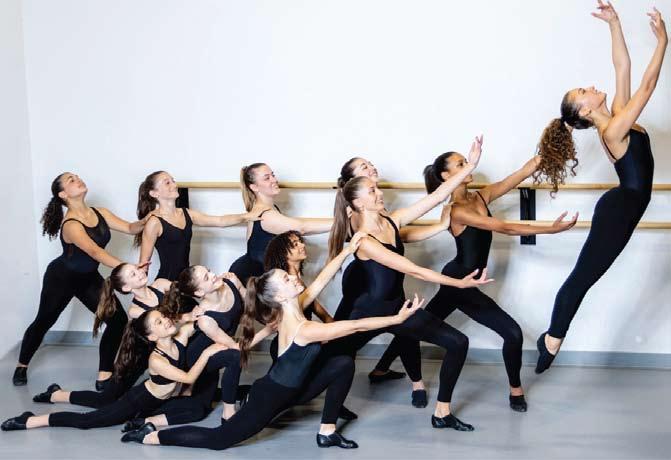
Coupé Theatre Studio
430 Market St., Nanuet 845-623-2808 coupedance.com info@coupedance.com
Coupé Theatre Studio provides a diverse range of dance styles, from Ballet to Tap, Hip Hop to Contemporary. The studio fosters an engaging and inclusive environment where students can explore various performing arts genres to discover their unique style. With a staff of passionate and professional teachers and guest instructors, students receive exceptional training in technique and performance. The studio offers recreational dance, adaptive programs, and a competitive dance team, catering to a wide array of interests and abilities.
Palisades Climb Adventure
4590 Palisades Center Drive, W. Nyack, NY
845-727-3500
palisadesclimb.com
Discover an exhilarating indoor adventure this Summer at Palisades Climb Adventure! Our world-record-breaking indoor ropes course, towering 85 feet high, boasts 75+ obstacles suitable for all ages and abilities. Conveniently nestled in the heart of The Palisades Center Mall, West Nyack, NY, They host private events, birthdays, team challenges, school trips, and scouting adventures. Little ones, 48 inches or shorter, can explore the Sky Tykes course. Join them for unforgettable thrills at palisadesclimb. com!


401 Market St., Nanuet 845- 623-2553
tumble-beegymnastics.com
Exciting developmentally age-appropriate activities for ages ten months to 12 years. Children 10 months to 3/3.5 years participate in parent participation classes. Older gymnasts work at their skill level in tumbling, bars, balance beam, trampoline, vault, dance, and more. The staff is highly trained on safety, child development, progressions, and students with special needs, and are First-Aid/ CPR certified. They offer open gyms, special needs classes, birthday parties, private lessons, special events, and more. Trial classes and payment plans are available.

By Marina DunBar
One of the best things about the backto-school season is that it’s also the back-to-extracurricular activities season! That means arts, clubs, and athletics are in full swing to ease the pressure of academics. And with this year’s unforgettable Summer Olympics, there has no doubt been a surge in aspiring young athletes going for the gold.
But how do you know when your child is ready for a sport? And how do you know what sport is ready for them? We’ve assembled a guide to help parents understand what sports best fit their kid, so that your little future Olympian will remember to credit you for their early start.
Ages 2 to 5
Walking is the first real sport that babies learn. Once that fundamental skill is developed, the more complex motor functions start to kick in. Not only is a love of exploration and discovery cultivated during this time, but so is muscle memory, a critical part of all athletics. Kids at this age should be encouraged to participate in activities that help progress the development of this crucial function.
Sports that facilitate freedom in play but also incentivize children to learn repetitive movements are ideal for inspiring early athletes. Some examples of early childhood sports are:
• Racing, including simple obstacle courses and mazes
• Jumping rope
• Dancing
• Basic gymnastics
• Throwing and catching a ball
• Swimming
• Hopscotch
• Riding a bicycle or tricycle
These are all activities that help children understand (both in mind and body) that repeating a movement over and over again is how it becomes easier to perform. And while it’s too

Ages 6 to 10
Once the fundamentals of muscle memory are acquired, it’s time to focus on balance, hand-eye coordination, and attention span. Parents can begin introducing sports with easy rules and basic gameplay strategy. When a child learns how to follow instructions, it’s a sign they’re ready for more complicated and collaborative sports such as:
• Baseball, softball
• Soccer
• Dance teams
• Martial arts
• Lap Swimming
• Roller skating and ice skating
These are all sports that build upon the foundation that is learned during the earlier childhood activities. Pay close attention to what sort of environment your child likes to be (Indoors or outdoors? In water or on grass?) and help them push themselves to learn that environment even more.
Ages 7-10 and Up
It’s junior sports league time! This is around the age your child will develop a stronger sense of teamwork, strategy, and sportsmanship. Of course, this also means a stronger drive towards competition. Cultivating a healthy sense of competitiveness is important in children of this age group, but it can be a tricky balancing act. You want your kid to want to win, but you also want them to be able to lose graciously.
A helpful way to encourage healthy
competition is to avoid always framing the conversation around winning and losing. Instead, remind your child that they’re playing because it’s fun and it’s healthy, and it’s still both of those things regardless of which side gets more points. Here are some friendly competitive sports:
• Football
• Basketball
• Volleyball
• Tennis
• Hockey
• Soccer
• Golf
• Competitive Swimming
If your child still insists that winning is everything, remind them that every athlete who loves their sport deserves to win sometimes, and that means that you have to lose sometimes. After all, it’s not really a competition if you win every time, is it?
With so many sports to choose from, it can seem overwhelming to try picking the best fit for your child. But that’s why it’s so important to pay attention during those early motor skill stages. Understanding the environment your child prefers as well as where their natural talents lie will give you a great idea of what activities they will enjoy and thrive in.
Do they constantly try balancing on the edge of the sidewalk? Try gymnastics and the balance beam. Do they like to make-believe they’re a superhero? Try martial arts. Do they love dancing around the living room with you? Encourage them to memorize a routine. The more they try, the more they discover what they love.
Ask any kid who their favorite teacher is, and it’s likely to be the one teaching their favorite subject (which explains why there are so many beloved gym teachers out there). So there’s a good possibility that the person leading the exciting activities your child attends after school - when the fun really happens - is someone they admire greatly and enjoy learning from. That’s why it’s so important that the staff at any afterschool programs your child enrolls in are trustworthy, knowledgeable and talented, like the professionals listed below who each serve as exemplary leaders in their respective fields. Read on to learn about the person who might be at the forefront of your child’s next afterschool adventure.
Annmarie Mancuso, Preschool Teacher
Annmarie has a great deal of teaching experience, and is also a mom of two children. She received her Masters in Education and a secondary specialization in Special Education. She taught in public school for years before becoming a part of the Bright Beginnings Pearl River Preschool. Annmarie entered into this profession because she wanted to “inspire and motivate children to help them discover their strengths”.



Diane Coupé Frankel, Artistic Director
Artistic Director Diane Coupé Frankel attended the Hammond School in Chester, England, the prestigious Arts Educational School in Tring, the London Professional School, and London College of Dance and Drama. She eventually settled in New York City appearing in the original cast of eleven Broadway Musicals including: A Funny Thing Happened on the Way to the Forum, Funny Girl, Mame, Coco, and Nowhere to Go But Up. She opened Coupé Theatre Studio in 1970 which currently employs 28 teachers and office staff.




Marie Wood, Owner
Marie Wood is the owner of Tumble-Bee. As one of the first students when Tumble-Bee opened its doors in 1986, Marie experienced firsthand the benefits of recreational gymnastics. She went up through the program, and started working at Tumble-Bee in 1999. In 2022, Marie became the owner of Tumble-Bee and is thrilled to carry on the Tumble-Bee legacy, and continue providing quality gymnastics instruction (and so much more more) in a safe, caring, and supportive environment!

Mommybites.com provides expertly curated resources for all parents in the New York area, including our most popular feature — our mom-generated nanny board — the best online source for parents to find vetted (by other parents), experienced nannies and childcare providers who want to work in New York City, Westchester, Long Island and Northern New Jersey. Visit Mommybites.com; we can’t wait to see you there! is now part of
BY DONNA DUARTE�LADD
When hiring a nanny, the process can be exciting; you will have expert help, and daunting; finding the right fit is super important to you and your family. Assuring your caregiver aligns with your family’s values, routines, and expectations is key to you and your child’s caregiver.
We connected with Adrian Niles, Executive Director; Charlene Niles, Managing Director; and Laura Davis, Nanny Concierge of Jovie. Jovie’s goal is to reimagine the nanny-babysitter experience for all involved.
Whether you are a first-time parent or looking to hire a new nanny, our guide with these expert tips will help you navigate the process with ease and assurance.
Is it essential to hire a nanny who has worked with children of similar ages as your child?
We recommend finding a nanny with at least 12 months of experience working with children in the same age range as your child. But remember, your children grow quickly! You’ll also need to consider how long you anticipate needing a nanny and consider someone with experience working with the ages your children will reach.
Should all nannies have specific certifications or training in childcare, such as CPR or first aid?
Certifications matter, some more than others. An important aspect of a nanny’s role is the safety of the children and the ability to handle any accidents. Having up-to-date First Aid and CPR Certifications should be an important requirement for your nanny. Infant and Child CPR differ from Adult CPR, so the right training is key. If your nanny needs this training, it’s common for the family to offer to pay for it.
Plus, it’s not bad for parents to receive this certification. This could be a great opportunity to gain helpful skills and bond
with your new nanny!
Should a different fee be involved if you ask your nanny to help with light household chores related to the children, like laundry or meal preparation?
Typically, nannies are responsible for the safety, engagement, and care of the children. This is their primary focus and should take precedence over other activities. Chores that are child-centric, such as cleaning up the playroom, doing the children’s laundry, or cleaning up from meals, are an expected part of the nanny’s job description. Depending
on the children’s age, the nanny might have time to add on other responsibilities. These additional duties should be discussed, agreed upon, and outlined in the employment offer terms.
The hourly wage for a nanny is determined based on the comprehensive job description and should include expected responsibilities. The final wage is determined by many factors, such as how many kids they’ll be working with, their ages, pet care, household duties that are non-child related, and similar expectations. A good rule of thumb—if it is related to the children, it’s
more in line with the typical nanny role and the typical nanny wage. Adding on household duties would increase the expected wage to more of a Nanny and Household Manager role and commensurate wage expectation.
Do you recommend signing a contract outlining expectations, responsibilities, and terms of employment?
Definitely! Just like any traditional job, having a clear understanding of the expectations and responsibilities is key. Putting the details in writing will help avoid awkward issues down the line and clarify any blurred lines around the employee-employer relationship. That’s why knocking out the details during the negotiation period is recommended. A clear job description with specifics of the role, hours, wage, benefits, pay dates, expense reimbursement, and many more details should go into the agreement. For example, many NYC nannies appreciate the inclusion of an unlimited ride MetroCard in their benefit package. Ultimately, the completion of a written contract will help the relationship between the nanny and the family.
Adrian Niles, Executive Director of Jovie, and Charlene Niles, Managing Director, share, “Two important and often overlooked responsibilities of a household employer are the payment of their nanny’s employment taxes and compliance with New York State’s Paid Sick and Family Leave and Workers’ Compensatiorequirements. Whether you choose to do it alone or engage the services of a placement agency, ensure that your legal obligations are adequately addressed.”
What are the most essential questions parents need to consider when hiring their first nanny?
Hiring a nanny for the first time is a big step for most families. It takes time to find the right balance. Families who have never had a nanny will benefit from hiring a nanny with several years of experience. Why? Because the grown-ups are adjusting to having in-home care for the first time, just as much as the children! A seasoned nanny can help shape their role according to the family’s needs and guide the partnership.
When searching for a nanny that’s the right fit for your family, the essential questions to ask are:
“Do you have verifiable experience caring for children similar to our child’s age? What about as they get older? Have you worked
Putting the details in writing will help avoid awkward issues down the line and clarify any blurred lines around the employee-employer relationship.
with a family size like ours before?”
“Can you share references from all past nanny or childcare positions you’ve held?” (Speaking to all past employers is key). “Can you discuss any gaps of unemployment you’ve had?”
Ask specific questions in the interview: “What would you make our toddler for lunch?” If they say they love to take children to the library, ask, “What are your three favorite books for a preschooler?” The most experienced nannies will have no trouble referencing Alexander’s Terrible, No Good, Very Bad Day with a smile or describing in detail how they will carefully cut the crusts off the sandwich and ensure it doesn’t touch the peeled apple slices.
You will also want to perform criminal background screens on any candidates.
What types of experience does a well-season nanny possess?
Hiring a nanny isn’t only about general childcare experience. Of course, the love of children and experience caring for children are key starting points. But the beauty of bringing a nanny into your home matches not only personality and style but the experience your family needs today and as your children grow. So, you want to dig deep into the specific experience with the ages your children are and will be during the length of the assignment. And, of course, safety and safe-care training and experience are key.
A well-seasoned nanny should have:
Work experience: At least two years of full-day care for children in the age range is needed. And get specific, how many hours per day; how many days per week? You want to establish that two years of experience is two years of full day care, at least three days per week. And, importantly, this experience should be in a family home. While daycare or preschool teaching experience provides a knowledgeable caregiver, being a
nanny (fully in charge and needing to rely only on themselves for the entire care) is different than being a part of a group care environment.
First Aid, Infant, and Child CPR certifications: that are current (ask to see the certification card) and from a reputable organization such as the Red Cross. If you have a pool or other body of water, include LifeGuard or similar Water Saving Training (and be sure your nanny can swim if water activities are part of the job description!)
Professional Development Trainings: This can be as extensive as a Degree in Child Development or a series of industry trainings specific to the ages under their care.
Experience planning: A seasoned nanny will want to engage with parents in planning activities, enrolling the children in classes and camps (and knowing the best ones to get into), anticipating developmental milestones (it’s time to babyproof the house as the little one is ready to crawl), handling back-toschool or end-of-school year activities, or getting the family ready for a vacation.
Newborn Care: If the role of the nanny is providing care to newborn(s), Newborn Care Specialist (NCS) Certification would be the gold standard. However, a well-seasoned nanny who is a mother herself can be a tremendous hands-on experience that results in amazing care.
Confidence in answering specific questions: Providing specific examples of situations they have handled as a nanny will help you in the interview process. Dig deep, such as: Name three books you’d read to a toddler. How would you approach the separation anxiety of the child while the parent works in the home? Provide a menu for the week for a preschooler’s lunches. The answers to these questions will give you insight into the nanny’s experience and comfort working with a parent to provide the best care and support to the family.
Don’t skip the references: Yes, you like the nanny, and she looks great…why references? Because references not only help you vet the nanny but also can give you tips on how best to work with the nanny. Also, review the resume for gaps in work and get explanations. Seasoned nannies will have no concerns explaining gaps—maybe they were waiting for the right family; maybe they took classes; maybe they cared for a family member.
You
can find this and helpful childcare articles on our sister site, mommybites.com.
By Emily lE vy
With summer winding down and fall up at bat, the reality that your child will be starting preschool may be sinking in. Much of preschool involves play and loads of fun, but arming your child with early academic foundations—in an engaging and enjoyable manner—can help set them up for preschool success. Try some of the ideas below.
Sorting objects is an important skill that will be tackled in preschool, so prepare your child with some sorting activities that you can practice at home. Purchase a bag of multicolored buttons, pom poms, or paper clips, and set out a six-cup muffin tray. Explain to your child that together you will practice putting all of the same color object into a single muffin cup. Make sure you model a few first. You should start by putting all the yellow buttons in one cup, blue ones in another, green in a third, and so forth. Then have them practice sorting on their own and praise them when they have successfully sorted all of the objects. Of course, as a bonus, this activity will reinforce color recognition.
Counting and number recognition are also important early-learning skills. Strengthen these skills by integrating counting exercises into everyday life. For instance, if you are at the supermarket, ask your child to count the number of apples or oranges as you put them into a plastic bag. When you remove items from your shopping cart and load them onto the checkout belt, have your child count each one to work on one-to-one correspondence. Have them count the number of clothing items you put in the washing machine, papers you need to complete for work, keys you have on your key ring, and so on. To add some number recognition practice, try playing a “game” where you label individual cups 1-10, with one number on each cup. Ask your child

to go around your house and find one item to put in the “1” cup, two items to put in the “2” cup, and so on. The more fun and engaging you can make these activities, the better!
While your child will likely learn more about letters once the school year begins, you can give them a prelude with some fun letter recognition games. Purchase a bag of plastic or foam letters and put them in a bowl. Write out the alphabet on a sheet of construction paper, then point to a letter and ask your child to “scoop up” that letter using a ladle or spoon. You can also try using chocolates for another fun letter game. To play this game, write two sets of single letters on small white stickers (two A’s, two B’s, etc), then attach them to the bottom of Hershey Kisses or other chocolates. Together, you can play a game of Memory. First you flip over one chocolate and identify the letter, then flip over another chocolate and try to find the letter match. Your child goes next, then you, and so on. The first player to find the most letter matches wins!
Problem-solving is a skill that will continue to play a role throughout your child’s academic career, so it’s helpful to start building this skill at a young age with some fun activities. Try playing “Guess the Item”
with your child, where you give them a set of clues and they need to try to identify the object. For instance, you might say, “I’m thinking of something that’s furry and has four legs and a tail,” and ask them to guess the object (dog) or “I’m thinking of something that’s long and thin, has an eraser at the top, and has a point at the end” and ask them to guess the object (pencil). If they struggle to guess the object, offer clues, like “you can write with it or sharpen it” for a pencil, or “it often wags its tail or drinks water out of a bowl” for dog.
Your child will need to follow a lot of directions once they start preschool so try some exercises at home to improve this skill. You can play the traditional “Red Light, Green Light” game with them, but with an added twist. Like the classic game, green means go and red means stop, but try throwing in some additional colors for added following directions practice. You may say that blue means bark like a dog, white means scratch his head, and pink means hop on one leg. Throwing in some of these other colors as directives will teach your child to listen carefully and follow the directions appropriately. Simon Says is another fun game you can play to build this skill. Your child must listen to the “commands” and follow the directions accordingly.










By KAITLyN RIGGIO
Let’s face it: sick days happen. Even with continual handwashing, cleaning and hand sanitizing practices, it’s virtually impossible to avoid getting sick once in a while. And when you can’t take a sick day from being a parent like you can take a sick day off of work. Family life continues while you’re trying to get better.
When you’re a parent, getting sick can throw a serious monkey wrench into your daily family routines. On top of focusing on feeling better, you’re also thinking about how to keep the household up and running while you’re out of commission.
We sat down with Dr. Julia Samton, psychiatrist from The Midtown Practice, about how parents can stay on top of parenting while sick or under the weather.
New York State has laws in place securing your right to sick leave from work. If you’re a working parent, knowing your employer’s sick leave policy can help you on the path towards resting and feeling better.
“Recognizing and knowing what your rights are is important,” Samton says.
It’s not really possible to predict when you’ll
get sick, but it’s bound to happen at one point or another.
Get ahead of the game by making a plan for what day to day life looks like when you or your partner get sick.
“It’s worthwhile to have a discussion, either with your partner or somebody that you’re co-parenting with, about a plan for what to do when you’re sick,” Samton says.
This plan won’t look the same for every family, but having an idea of what to do when sickness strikes can ease a lot of stress when it inevitably happens.
Parenting is never a one-man show, but that’s especially true when you’re sick. While putting together your sick day plan, brainstorm with your partner who you could call if you need extra support.
“I think you want to have a short list of people who can be on call, whether that’s friends, family members or babysitters,” Samton says. “Have a list of not just one or two, but five or six people.”
If you’re not located near family or you run out of support on your list, look into options like an emergency nanny (often offered through nanny agencies), after school programs or community programs.
Bringing in a friend or an emergency nanny might be a good choice, especially if
you or your partner work remotely.
“If you have someone new watching your kids or helping you out, you will be at home,” Samton says. “So even though you can’t be doing as much because you’re I’ll, you’ll be at home to supervise.”
Even with the best plans, not everything is going to go perfectly on a sick day. Between the changes in routine and not feeling at the top of your game physically, things are bound to go wrong at one spot or another.
Knowing and accepting that things won’t be perfect on a sick day is half the battle.
“It’s important to recognize your limitations, because we all have limitations, and accept the fact that not everything has to be perfect and things aren’t going to be able to get done in the same manner when you’re not feeling physically well,” Samton says.
This might be hard to handle, but things going awry when you’re sick doesn’t mean you’re a bad parent. And accepting this will make focusing taking care of yourself on a sick day much easier.
“We just have to really work on accepting and recognizing our limitations and realize that that’s not a statement on who we are as a parent or as people,” Samton says. “The quicker you accept your own humanity, the better.”

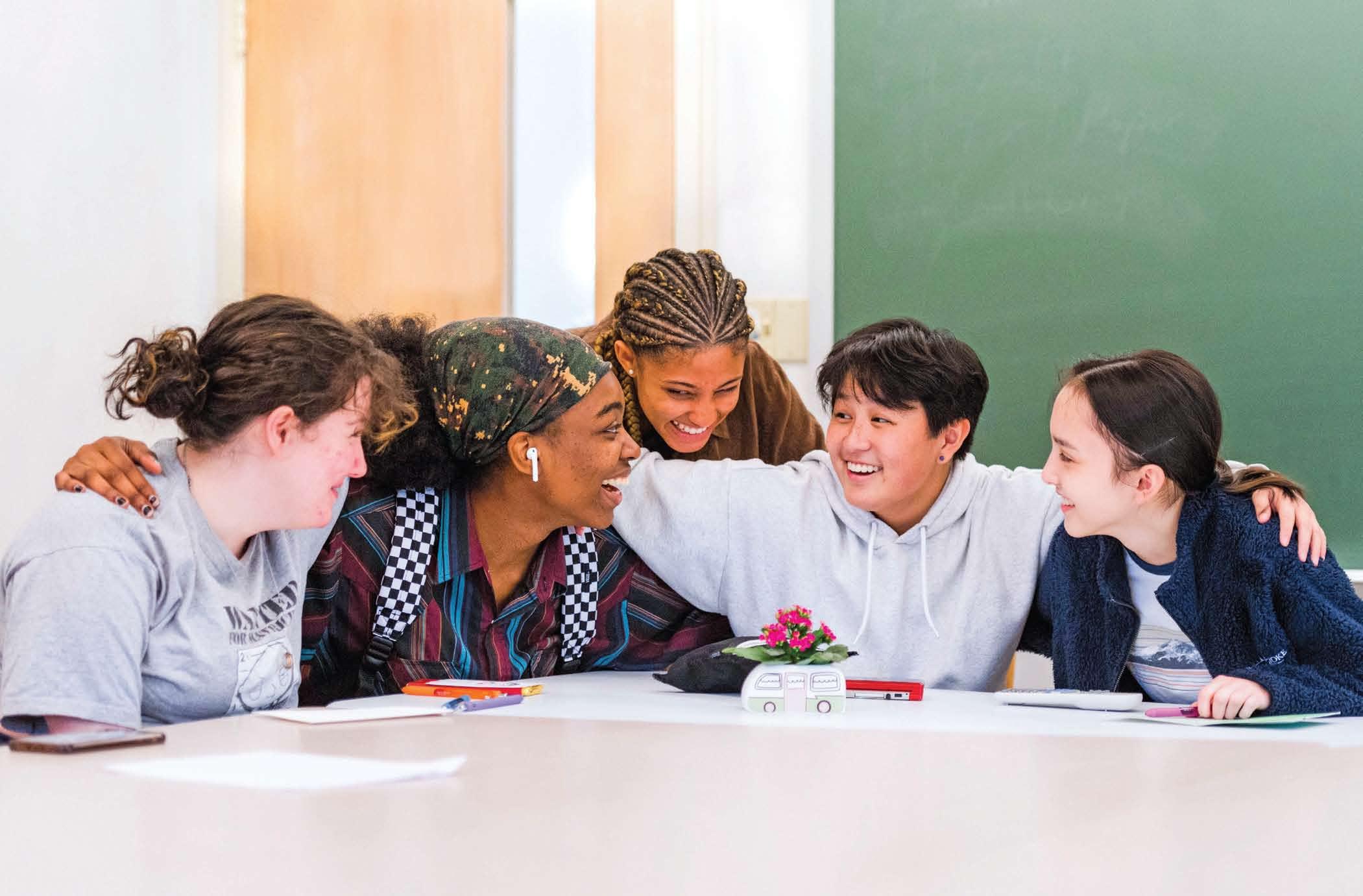

By Thalia Fernandez
Almost a decade ago, on June 15th, 2015, Inside Out made its mark in cinema and has since become one of Pixar’s universally beloved childhood gems. The film’s themes of navigating change and understanding emotions resonated universally with viewers and families, making it a relatable experience for moms, dads, and kids. It had just about anyone who watched shedding a couple of tears in theaters. So, the expectations for Inside Out 2 were high.
While sequels rarely do better than the original, Inside Out 2 did not disappoint. In this sequel, we see Pixar take something as universal and complex as puberty and break it down in such an excellent way that allows parents and children to walk away feeling seen, have space to create open dialogues about complex emotions, and, overall, leave families feeling comforted and with a sense of relief when navigating this period of life that comes in hard and fast for all families.
This movie has many gems and key takeaways for parents and children, making it a must-watch. Educational professional Tyreca Elliott, Manager of KinderCare’s Inclusion Services team, agreed and kindly shared her insights on the film. She also gives us some excellent strategies for navigating complex emotions at home and in the classroom. But before diving into everything, I have to leave a spoiler warning; it’s just good movie etiquette, so if you haven’t watched and are planning to, save this and return to it later. Alright, you’ve been warned.
It’s now 2024, and we’re meeting up with Riley and her emotions again. While things have finally settled in San Francisco, Riley is now thirteen and is thrown into puberty overnight. While joy, sadness, fear, anger, and disgust clock out for the night and peacefully slumber, an alarm goes off on the control panel, and it’s officially demo day; puberty comes in like a wrecking ball and changes everything.
Riley wakes up from her sleep, and as the emotions try to start working on the
panel, the slightest touch creates a heightened sense of emotion, which we see when she’s speaking to her mom. Anger touches the panel, and Riley responds with heightened anger. We also get a glimpse of mom’s inner dialogue when her emotions think, “We just got a glimpse of the next ten years,” while commenting on Riley’s smell. It perfectly depicts our feelings and how we grow through puberty.
Parents and children can watch and relate to this moment because puberty comes without warning and settles in pretty intensely, and this is all perfectly normal, according to Lisa Damour, an American clinical psychologist and author who worked alongside Pixar to help develop this sequel by sharing her expertise on the reality of puberty in adolescents.
Damour helped develop the new emotions in this film because puberty brings a much more complex set of emotions. This time around, we’re meeting envy, embarrassment, ennui, and anxiety. There’s nostalgia, too, but we won’t see that feeling for a few more years.
As the new emotions settle in and Riley begins to navigate puberty, she gets hit with the news that any thirteen-year-old would find devastating: Her friends will not be attending the same high school as she is. The news sends just about every emotion into shock, and we begin to see anxiety slowly come in and take over, wanting to protect Riley from the potential loneliness of trying to figure out life at a new school without her friends.
The movie dives into what life is like when anxiety takes over and what that can look like for teens and, honestly, anyone who watches. Riley’s anxiety is a perfect depiction of what happens when we experience anxiety. It hits every key point of how anxiety works in our minds. Anxiety thinks of every possible scenario of how things can go wrong to try and prevent them from happening, pushes Riley to try and be the best so that she won’t have to feel alone, and eventually leaves her with this overwhelming feeling that not even anxiety, the emotion in the movie,
saw coming: Riley feels like she’s not good enough.
The sense of not feeling good enough, coupled with Riley’s isolation from her friends, lack of sleep, and overall loss of her sense of self, leads her to have a panic attack. This moment, in particular, stands out as a critical moment that is significant for families to watch. It illustrates what a panic attack can feel like and why it may come on, and it is a great way to open up a dialogue with kids on how to handle these moments that are more common than people think.
In the film, Riley settles down by doing some key things: slowing down, focusing on her breathing, and touching her seat. All forms of grounding techniques that can help during a panic attack. While the film does a great job of introducing us to complex emotions, we aren’t given much information on strategies for managing these emotions in the real world. Here’s where our expert from KinderCare Inclusion Services comes in.
KinderCare is dedicated to providing the best early education for children, offering expert care and proven programs in safe, reliable centers. We had the pleasure of asking Tyreca Elliott, Manager of KinderCare’s Inclusion Services team, parent, and former KinderCare Learning Center classroom teacher, some questions about anxiety and how Inside Out 2 approaches this universal feeling and experience.
What key takeaways should parents and children consider after watching Inside Out 2? Inside Out 2 allows families to talk about the variety of emotions we all feel every day. Parents can use the movie as the jumping off point for conversations with their children about how they’re feeling by asking questions like “Have you ever felt like that before?” or “Remember when Riley felt like (emotion)? I feel that way too sometimes, what about you?” It’s a great opportunity to help kids identify and name their emotions, normalize sharing how they are feeling, and learn tools to manage feelings as they come up.
How can Inside Out 2 be used to teach emotional intelligence and mental health?
Parents can use Riley’s experiences to show their kids that it’s OK to feel different

emotions and that they can express those emotions in healthy ways. They can also learn to recognize other people’s emotions and learn to empathize when others are feeling similar emotions. Providing that kind of support and using encouraging dialogue will help teach kids emotional intelligence and give them a solid foundation for managing their mental health.
What are some common signs of anxiety in children and adolescents that you’ve seen first-hand?
Experiencing some anxiety is a normal part of child development. Anxiety can show up in different behaviors among young children, depending on their age, like being restless and having trouble sleeping, consistent worry or fear, or sudden big emotions like anger or crying. When kids are experiencing anxiety, it’s important to be present with them, help them express their feelings, name the emotions they’re experiencing, and show them ways to cope,
like taking deep breaths.
How does anxiety affect a child’s performance in school and social interactions?
Anxiety can often impact sleep schedules and lead to children feeling tired and unable to concentrate at school. Kids may shy away from their friends or social interactions to avoid anxious feelings. While anxiety can impact kids in different ways, ultimately, it can make it harder for them to engage in classroom experiences with their peers or engage in new experiences.
Can you share any strategies for managing anxiety and any other complex emotions at home and in the classroom?
It’s important to teach and practice coping strategies when the child is calm. Once families or teachers begin to notice a change in the child’s mood or if there are things that typically cause anxiety or big emotions, adults can then reference the tools the child has already learned. By helping the
child identify when they begin to feel those particular emotions, the child will learn to ask for help from an adult and then begin to regulate their emotions on their own.
For example, when kids are feeling overwhelmed, parents can take the time to acknowledge and validate their children’s feelings, hear their point of view, and offer them the support they need. Every child is different – some kids need hugs, while others need to talk about it or just have a caring adult be present with them as they work through it. Some children may need to express their emotions through big-body play or have a fidget or comfort object to squeeze or cuddle while they regulate.
Inside Out 2 has become a box office hit and might be an essential watch for families with teens learning to navigate a new world of emotions. It’s a great watch for all ages, and we definitely recommend heading out to the movies and watching this summer’s must-see animated film.
Could your child have the eating disorder ARFID?
By Kaitlyn RiggiO
Let’s face it: almost every kid goes through a phase of being a picky eater, where getting them to eat something other than their favorite crackers and chicken nuggets can be a real struggle.
But what if you’re suspecting it’s more than just a phase? Or if it’s starting to impact them outside of meal time? Maybe it’s stopping them from going to birthday parties or playdates, or it’s causing massive arguments in your house at dinnertime.
Having a child who is a picky eater is developmentally expected, but when your kid’s eating habits are highly restrictive and start to impact other parts of their life, they might have Avoidant/Restrictive Food Intake Disorder, or ARFID.
We sat down with some experts to talk about what parents need to know about ARFID and how it might be treated.
What distinguishes ARFID from a picky eater?
Dr. Sarah Parker, director and co-founder of the Reeds Center, describes ARFID as a condition where “a person has an extremely limited range of foods that they can tolerate or eat” to the point that they’re “experiencing a good deal of suffering or some level of impairment, like it’s getting in the way of important activities.”
This impact on important activities is what distinguishes ARFID from picky eating. A child with ARFID might fall off their growth curve or suffer from nutritional deficits, for example.
The impacts of ARFID expand beyond physical health.
“We’re seeing a lot of psychosocial functioning impairments,” says Amanda Smith, director of ARFID programming at Monte Nido Walden. “Like, they’re not going to sleepovers, they can’t do class parties, they can’t do doughnuts with parents at school.”
What causes ARFID?
There are three different ways that ARFID typically presents itself that causes restric-

tions on food intake.
Sensory Difficulties : When ARFID presents through sensory difficulties, the taste, texture or smell of some foods can elicit strong feelings of disgust.
“There’s a heightened sensitivity, which leads to a very selective approach to which are acceptable,” says Melissa Gerson, founder and director of Columbus Park.
Fear of Adverse Consequences : As opposed to a sensory difficulty, ARFID stemming from a fear of adverse consequences is more of an anxiety or fear process.
“So many people with ARFID have anxiety about how food is going to affect them,” Parker says. “Or there’s going to be some kind of negative outcome if they eat a particular food.”
These fears related to food can be varied.
“They can be afraid that if they eat, they might choke on the food, or that it might make them sick or vomit,” Gerson says. “That can come on suddenly, or it can kind of build up over time.”
Lack of Interest : People with this type of presentation demonstrate a lack of interest in food and eating.
“It’s a chore,” Smith says. “Too much thought has to go into it, and they would just rather not.”
What’s also worth noting is that regardless of how ARFID presents, it’s not triggered by or related to body image or weight. While ARFID is classified as an eating disorder, this is what distinguishes it from eating disorders like anorexia or bulimia.
When Should Parents Look Into Seeking an ARFID Diagnosis For
Their Kid? What Does Treatment for ARFID Look Like?
Parents know their kids best, and the experts we spoke to said to reach out to their pediatrician if they notice their children’s restrictive eating habits are impacting things like their weight or ability to get important nutrients.
Another reason to seek out a diagnosis is noticeable interference with social functioning.
“If your kid has a hard time going to camp, or going to school, or eating with friends,” Gerson says. “That’s impacting their social life and their social connections, so that would be a really good reason to begin to explore.”
Conflicts within the family surrounding food are another thing to look out for.
“If a kid is refusing to eat food and it’s turning into an emotional issue in the family, it seems like that’s a useful time to kind of make an appointment with a pediatrician to find out more about what’s happening,” Parker says.
When it comes to treatment for ARFID, Smith says it typically involves a “multidisciplinary approach to try and really tailor to an adolescent or child’s needs.” From there, treatment might include weight restoration, if it’s needed, and then working to break through blocks eating certain foods before trying to expose the child to new foods and work on building their variety.
Treatment will also vary based on how the child is presenting ARFID. For example, exposure work might be prioritized if a child’s food avoidance is being driven by fear, while a child with sensory issues might be introduced to smaller changes to increase their tolerance and variety of foods they can eat.


We have 164 lakes perfect for swimming, boating, and fishing. We also have soothing hot tubs, saunas, and an indoor waterpark—where it’s always 84°. Dive in. Our charming, small towns are bursting with food, drink, and fun in any season.
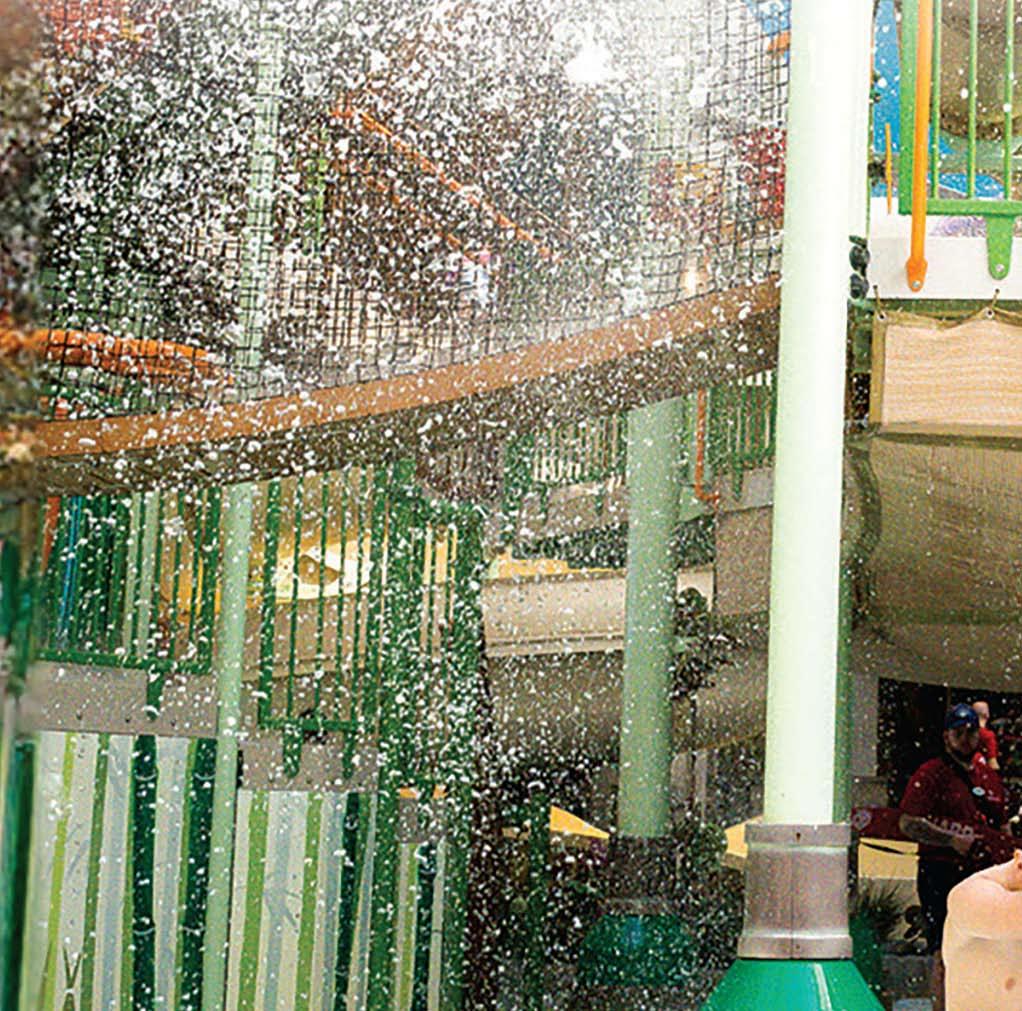
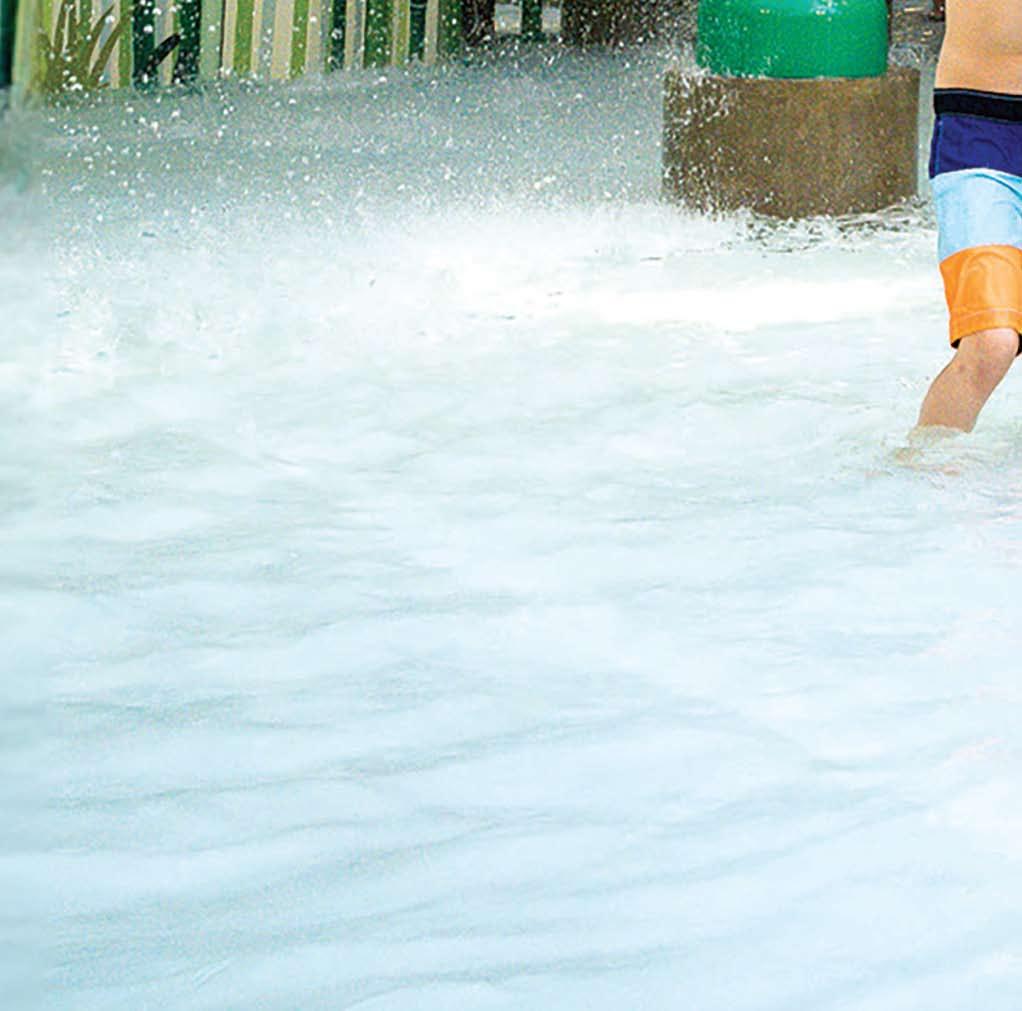
Mini vacays… longer stays, or anything in between — we’re just a short trip away.





Can you believe it? Apple picking season is upon us. And while the start of the school year isn’t always easy, there’s something special about fun fall activities like apple picking that makes this transition a little easier. These New York farms offer fun experiences for kids of all ages with delicious apple cider donuts, rides, animal experiences, and of course apples! Check out our list below of the best places to pick apples in the area!
rockland county apple picking
Dr. Davies Farm
Dr. Lucy Virginia Meriweather Davies started a farm in Congers, NY in 1891. Today, the fourth and fifth generations of The Davies Family continue the legacy, welcoming everyone to see the last family farm in Congers. Apple picking begins on August 31st, and will be available from 10 am to 4 pm on both weekends and weekdays. With over 5,000 trees and 27 different apple varieties across 65 acres, visitors can rent picking poles for hard-to-reach apples. All orchard visitors must purchase an apple bag for their pickings. Admission is $15 per person, which includes a 1/2 peck bag, or you can upgrade to a 1/2 bushel bag for $57, including admission for up to 5 people. Families should note that apple picking is cash only. 306 NY-304, Congers, NY 10920, 845-268-7020, www. drdaviesfarm.com
Westchester county apple picking
Harvest Moon Farm & Orchard
Pick-your-own apples at Harvest Moon & Orchard starts in September and runs until October. Enjoy beautiful views of the Hudson Valley and fall foliage, families will also love eating their signature warm apple cider donuts and enjoying a BBQ lunch with live music in the background. After apple picking, be sure to visit their on-site store for local produce, pies, breads, and fresh baked goods. Open from Monday-Sunday from 9:00am-5:00pm. 130 Hardscrabble Road, North Salem, NY 10560. 914-485-1210, harvestmoonfarmandorchard.com
Stuart’s Fruit Farm
A family-operated story since 1828, families
will love spending a day at Stuart’s for apple picking, a hayride, and shopping at its farm stand to purchase apple cider donuts and homemade pies. Opens for apple picking on September 6th from 9:00am-6:00pm. 62 Granite Springs Road, Granite Springs, NY 10527. 914-245-2784. stuartsfarm.com
Wilkens Fruit & Fir Farm
Wilkens opens for the season in August. The pick-your-own apple season starts in September and runs until mid-October where you and your family can pick a variety of apples such as Gala, McIntosh, Baldwin, Golden Delicious, Crispin, and Fuji. Apple cider donuts, pies, loaf breads, strudels, brownies, and more are available for purchase at the on-site bakery. Pick-your-own hours are 10:00am4:30pm from Wednesdays-Mondays. 1335 White Hill Road, Yorktown Heights, NY 10598. 914-245-5111. wilkensfarm.com
d utchess county apple picking
Cedar Heights Orchard
This farm offers Cortland, Gala, Calville Blanc D’Hiver, and Yarlington Mills for picking. Stay tuned to their social media channels for the announcement of their opening date. 8 Crosby Lane, Rhinebeck, NY 12572. 845-876-3231. rhinebeckapples.com
Fishkill Farms
Reservations are required before you pick at this popular farm. Families can pick from over a 100 varieties of apples (depending on the month/when you visit). Apple picking starts at the end of August where you can find Earligold apples and Ginger Gold apples. In September, families can pick Fuji, Empire, Gala, Red Delicious, and more. However, their apple (and other fruit) offerings are constantly changing so check out their website and social media pages before you visit. 9 Fishkill Farm Road, Hopewell Junction, NY, 12533. 845-897-4377. www.fishkillfarms. com
Rose Hill Farm
Rose Hill Farm offers tons of apples for picking from late-August to mid-October. There is also an on-site market, a tap room,
music and special events, and regular popups throughout the season. Additionally, this family-owned farm utilizes holistic growing practices with a focus on plant and soil health. 14 Rose Hill Farm, Red Hook, NY 12571. 845-758-4215. pickrosehillfarm.com
Greig Farm
You can pick apples at this family-owned farm from late-August to early October. Here you can find Red Rome, Stayman-Winesap, Jonamac, McIntosh, Gala, Red Delicious, and more. There are also four-miles of farm trails for walking/exploring and a family of goats behind the market that your kids will love feeding. 227 Pitcher Lane, Red Hook, NY 12571. 845-758-1234. greigfarm.com
Lawrence Farms Orchards
Find apples for picking from late-August to October at this farm. Varieties include Macintosh, Jonamac, Honey Crisp, Gala, Empire, Cortland, Red and Golden Delicious, Ida Red, Mutsu, Jonagold, Staymen, Northern Spy, Fuji, Rome, and Granny Smith. There is also a concession stand at the farm where you can get ice cream, apple cider donuts, milkshakes, and more. Admission starts at $7 per person from Monday-Thursday and $10.00 per person from Friday-Sunday. Kids under two are free. 306 Frozen Ridge Rd, Newburgh, NY 12550, 845562-4268. lawrencefarmsorchards.org
Mead Orchards
Apple picking starts at the end of August where you can find Cameo, Cortland, Crimson Gold, Galam Querina, Pink Lady, RubyFrost, SnapDragon, and tons more. 15 Scism Road, Tivoli, NY 12583. 845-756-5641. www.meadorchards.com
u lster county apple picking Apple Hill Farm
Take a road trip to the Apple Hill Farm in New Paltz. The pick-your-own season starts in September where you can find McIntosh, Opalescent, Empire, Mutsu aka Crispin, and more. The farm store also sells apple cider and apple cider donuts as well as offers hayrides. 124 Route 32 South, New Paltz, NY 12561. 845-255-1605. applehillfarm.com
Hurd’s Family Farm
The season at Hurd’s kicks off in August, with their Fall Festival on August 24th. Apples at the farm include Ginger Gold, Paula Red, Empire, SnapDragon, and more. All apples must be picked in a Hurds Family Farm Bag that is purchased before you start. The farm also offers rides and attractions for kids, such as a cow train, obstacle course, hayride, corn maze. and a mini zip-line. 2187 State Route 32 Modena, NY 12548. 845-883-7825. www. hurdsfamilyfarm.com
Jenkins-Lueken Orchards
This orchard opens in September where you and your family can find over 500 varieties of apples. Some types of apples include Gala, Honeycrisp, Empire, Cortland, and more. 69 Yankee Folly Road, New Paltz, NY 12561. 845-255-0999. www.jlorchards.com/u-pick/ apple-picking
Kelder’s Farms
Apple picking at Kelder’s Farm runs from mid-August to October. Varieties include Ginger Gold, Jonamac, Honeycrisp, Empire, Rome, Crispin, and more. This farm is also known for their plethora of activities where you can enjoy corn mazes and farm
attractions. Some popular options include a jumping pillow, combine slides, and mini golf. Kelder’s Farms is also home to the World’s Largest Garden Gnome, which is sure to be super fun for some memorable family pictures. 5755 US Route 209, Kerhonkson, NY 12446. 845-626-7137. keldersfarm.com
Prospect Hill Orchards
Pick apples starts early September at the Prospect Hill Orchards’ family of farms. This includes the Homestead Farm at Prospect Hill where you can find 15 acres of apples, along with a pond and picnic area; the Hilltop Farm at Prospect Hill with incredible views and easy-to-pick apples; or the Clarke’s Family Farm, a working farm. You can also enjoy a tractor pulled hayride, a corn maze, and the chance to hand press your own cider. 40 Clarkes Lane, Milton, NY 845-795-2383. prospecthillorchards.com
Ochs Orchard
The apple-picking season runs from late August to late November at Ochs Orchard. Families don’t need a reservation to pick. In addition to the apples, Ochs has an on-site farm market stocked with seasonal fruits and
veggies and a stand where you can get homemade ice cream! 4 Ochs Lane, Warwick, NY 10990, 845-986-1591, www.ochsorchard.com
At Bishop Orchard, families can stop by during apple-picking season from late August to late October. While at Bishop Orchard’s, visit their farm market stocked with fresh produce, cheese, bakery items, and bulk staples. Families can also enjoy ice cream, cider, and wine. 1355 Boston Post Road, Guilford, CT 06437, (203) 453-2338, bishopsorchards.com
At Samascott Orchards, families can begin enjoying pick-your-own apple season at the end of July when the arrival of their early apples become available. The admission fee is $5.00 per person, with a discounted price of $2.50 for seniors aged 65 and above. Children aged nine years and below and military personnel carrying ID can enter for free. The produce is priced per pound and is not included in the admission fee. You can get a discount of 10% if you pick produce worth $20 or more. 5 Sunset Ave, Kinderhook, NY 12106, (518) 217-2868, samascottorchards.com
By Shara Levine
Since becoming a parent almost 17 years ago, my husband and I have gone away together a total of zero times. Not a weekend, not an overnight, nada . We had so many excuses, more like four of them- our children. And while I know how important it is for couples to spend time together, let’s face it, this is easier said than done. But sometimes, an opportunity presents itself, and you just have to go for it. Royal Caribbean, known for their world-class cruises featuring 29 different ships and more than 300 destinations, reached out to invite me on a seven-night cruise to the Bahamas, with a stop in Florida, on their Symphony of the Seas ship sailing for the first time ever from the New York area. And, of course, I accepted. Actually, it was more like as soon as I checked my schedule, my husband’s schedule, and my children’s schedules, then I accepted.
Schedules were cleared; now, on to child care. I am fortunate enough to have my parents nearby, and I presented them with an opportunity to spend quality time with their precious grandsons for seven nights. Who would pass up the opportunity to ferry four adorable children to and from school, extracurricular activities, friends’ houses, and, of course, feed them for a whole week? Apparently, not my parents. Bless them. With childcare sorted out, I was able to start planning for our vacation for two.
I started to think about what to pack, which was going to be a breeze, considering I usually pack for five. Of course, I packed the swimwear, casual clothes for daytime, sunscreen, and hats, but I also needed to consult the Royal Caribbean app to find out what kind of theme nights there would be so that I could pack accordingly. We had white night, 70’s night, Caribbean night, and formal night. I was a little nervous for formal night, but I was assured that there is a range of what is considered “formal,” so I didn’t need to
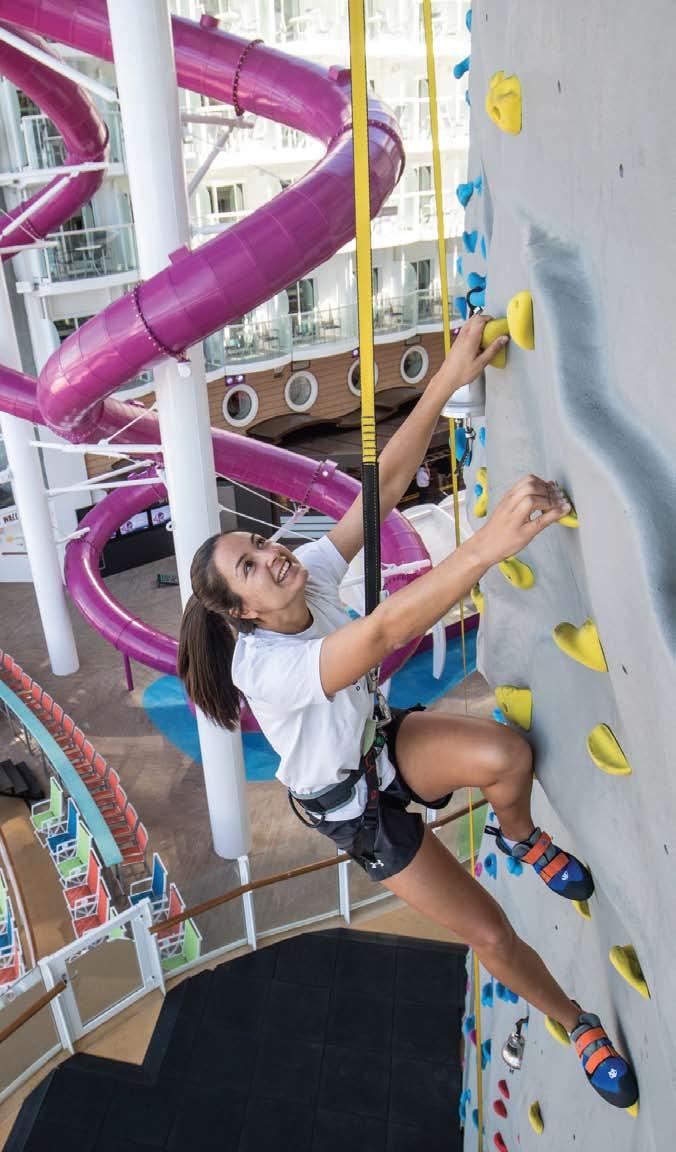
bring a ball gown- but I totally could have if I wanted to. I stuck with a classic black dress, but there were families in everything from shirts, ties, and sundresses to full formal with tuxedos and gowns. Everyone looked beautiful, and it was fun when the whole ship participated. I also packed a book, which sounds like a basic item to bring with you on a trip, but normally, when I vacation with my family (and I use the word “vacation” loosely), I’m so busy planning activities, packing snacks, and breaking up fights, that I never have time to crack open a book. But not this time, because I was going on a real vacation, and I could read anything that I wanted, but it certainly wasn’t going to involve an underpants-wearing caped crusader (no offense, Dav Pilkey.)
As the countdown continued to our first vacation ever since the kids were born, I
created a document for my parents with daily itineraries for each child: what time they needed to be in school, what time they needed to be picked up, and which days they need to be at after school programs. I also went shopping to stock my parents’ home with snacks for school, chicken nuggets, fish sticks, and hot dogs to make sure that there were plenty of backup options for when the kids refuse my mom’s dinners, just like when they refuse mine (spoiler alert: they ate everything she served.) I was really nervous for them, but I told them to be brave and reminded them that I was only a phone call away. Then I said goodbye to my kids.
Download the Royal Caribbean App, and do this way before your trip. The app provides a wealth of information and includes your daily itinerary with activities, shows, games, theme nights, a map of the ship, dining options, schedules, and more. The amount of activities on the ship can be overwhelming, so it’s a good idea to go over what you may want to do before you board. You can also use the app to make reservations for shows, book excursions, purchase internet, and drink packages, order photos taken onboard, check-in for your trip, fill out necessary documents, and more. If you prefer to see the daily itinerary on paper, you can visit guest services, which give out the “Cruise Compass” newsletter with a list of the day’s events, games, activities, weather, and “drink of the day.”
The big day arrived, and we loaded the car and made our way to Bayonne. Over the years, people have told us how wonderful cruising is, but I never gave it much thought because I could never justify paying to fly and stay at a hotel to get to a port that is far away. With the Symphony of the Seas ship departing from New Jersey, it’s only a quick drive away from my home on Long Island, cutting out the need for extra travel expenses. We arrived at Cape Liberty and checked in

during the time frame that we were assigned through our Royal Caribbean app. A friend gave me a heads up that we wouldn’t receive our luggage right away and to take a carryon with us with the things we would need immediately- sunscreen, change of clothes, toiletries, etc. We also made sure to have our passports with us. Don’t leave that at home! I must have checked my bag ten times to make sure that we had them with us. We entered the terminal, which was very similar to an airport terminal, went through security, where I presented my passport, which I knew for a fact that I had not left at home, and made our way onto the ship.
On our way to our room, we were greeted by Ida, who introduced himself as our Stateroom Attendant for our Ocean View Balcony room and let us know that he was available if we needed anything. And he was. Just like the other members of the staff that we would soon be meeting, Ida was warm, friendly, and knowledgeable and made sure to call us by name whenever we saw him. I knew right then and there that I could never work on a cruise ship because my ability to remember anyone’s names, not even my children, would immediately disqualify me from working for Royal Caribbean. When we entered the room, we were instantly grabbed
by the stunning view from our balcony. Even though we were still docked in Jersey, we had the Manhattan skyline to admire. The room was spacious, with a comfortable king-size bed, a couch that pulled out for more guests, a closet with plenty of space to hang clothes, and a wall-mounted television. I never needed to use the magnetic hooks for this sized room, but if I was traveling with my children, then I might have.
It was almost time to depart, so we went to the 16th floor to wave goodbye to those on shore. You could feel the excitement of everyone on board, ready to start their vacations. Our fellow passengers included families (small and large), retirees, honeymooners, couples, and even a wedding party- yes, you can get married on a Royal Caribbean cruise ship! The 16th floor and 15th floors of Symphony of the Seas are home to the pools, jacuzzis, waterslides, ziplining, FlowRider surfing simulator, basketball courts, ping pong tables, miniature golf course, pickle ball court, The Perfect Storm water slides, The Ultimate Abyss which is a high-speed dry slide that takes you from the 16th floor to the 6th floor in a dark tunnel with flashing lights- it’s so much fun!
Speaking of the 6th floor, aka The Boardwalk, is not only the landing pad for
The Ultimate Abyss, but home to a carnivallike atmosphere featuring a beautiful carousel, carnival games, netted climbing wall, the Auqatheater, and the entrance to the rock climbing wall. If you’re feeling hungry and nostalgic for fair food, stop by the Dog House for a classic hot dog with all of the fixings or choose from a variety of sausages. Need a sugar rush? Check out the specialty shop Sugar Beach for an endless array of sweet treats, ice cream, and kids’ workshops. Sugar Beach and select restaurants, like Johnny Rockets and Playmakers Sports Bar & Arcade, are not included with your cruise but offer passengers the opportunity to dine on a variety of specialty fares.
On the other side of the 6th floor is the Vitality Spa & Fitness and the Vitality Cafe. Here, you can pamper yourself with facials, body wraps, massages- alone or with your someone special, and so much more. The state-of-the-art gym features machines, weights, classes, and health seminars. Some of the classes are included with your trip, while others require an additional fee. The Vitality Cafe is located at the entrance of the area and features an array of smoothies, protein shakes, and juices. Don’t see what you want on the menu? You can create your own and enjoy a personalized beverage (I liked ordering my
juice with beets, oranges, and apples!) There is a fee for the items on the Cafe’s menu, but they are included in the Deluxe and Refreshment Beverage Packages.
While we are on the topic of drink packages, let’s break it down. There are three drink packages to choose from: the Classic Soda Package, the Refreshment Package, and the Deluxe Beverage Package. The Classic Soda Package is exactly what it sounds like and includes fountain sodas and refills, access to the Coca-Cola Freestyle beverage machine, giving passengers the option to mix and create soda blends, and includes a souvenir Coca-Cola Cup. The Refreshment Package includes everything in the Classic Soda Package, plus premium coffee and teas, freshly squeezed juices, bottled water, non-alcoholic cocktails, and milkshakes at Johnny Rockets. The Deluxe Beverage Package includes everything that the Refreshment Package includes, plus cocktails, spirits, liqueurs, beers, and wine by the glass, all up to $14. None of the packages include beverages purchased inside licensed Starbucks, but the Starbucks drinks served at the Cafe Promenade (open 24 hours a day) are included. Beverage packages are optional, but when one person in your room buys it, you all have to buy it for the entire duration of the trip. You can purchase your drink package on the ship, but there is often a discount if you purchase it prior to your trip on the Royal Caribbean app.
Another purchase you’ll want to consider is an internet package. Depending on the length of your cruise, you may not feel it’s necessary to have the internet and might welcome being disconnected for a while. But

as a parent leaving kids on land, I think it’s a necessity. Unlike the drink packages, you can share the internet because it’s based on how many devices are used. We had an internet package that allowed for two devices, so if I needed to use my laptop, I would disconnect the internet from my phone and then connect it to my laptop. Since my husband still had his internet connection to his phone, we were still reachable. You can purchase this on the ship or purchase in advance at a discounted rate. There are combination drinks and internet packages as well. You do not need to purchase an internet package to use the Royal Caribbean app.
And while you’re pre-purchasing your drinks and internet, browse through the Royal Caribbean app to explore the many excursions offered on your cruise. Excursions are optional and are an additional fee. If you decide to stay onboard, you can continue to enjoy all of the amenities that the ship has to offer, or you can leave to do your own
ID Lanyard: You will get a Sea Pass that works as a room key, credit card, and drink package pass, and having an ID lanyard makes it easy to carry around- especially when you don’t have pockets.
Magnetic Hooks: The rooms’ walls and doors are magnetic, so put up some hooks to create more storage space where you can hang things for easy access.
Towel Clips: It can get windy by the pool area, so use clips to secure your towel to your lounge chair and let others know that this seat is taken.
Soft Luggage: A friend who recently went on a cruise with her family suggested I take luggage that could collapse

thing- just make sure that you are back before departure time. We had the option to go on excursions when we made stops in Orlando, Florida, and Nassau, Bahamas. In Orlando, we visited the Daytona International Speedway, where we got an exclusive, behind-the-scenes tour of this historic sports complex, took pictures in the winners’ circle, and traveled through racing history at the Motorsports Hall of Fame of America. In the Bahamas, we toured Nassau, learned about historic buildings, and made stops at a rum cake shop for delicious souvenirs and the John Watling’s Distillery, where we were greeted with refreshing pina colada samples. Some of us had more than one, but I’m not going to name names.
During our second day in the Bahamas, everyone was invited to disembark for a Perfect Day at CocoaCay. CocoaCay, an island exclusive to Royal Caribbean, is included with your cruise to the Bahamas, and offers passengers a full day of fun in
and be stored under the bed when not in use. I thought this was a great idea, but I’m pretty sure that we were the only ones with rolling duffle bags while everyone else was using regular structured rolling suitcases. But do make sure that however you transport your luggage, it does have wheels. I’ll talk more about why later.
Cruising Ducks : We met this lovely couple at dinner one night on the cruise, and they told us all about Cruising Ducks . This is really a thing. You pack little rubber duckies to hide around the ship for other passengers to find. You can also purchase tags to attach to them to make it more personal. If you find a duck, take a photo and post it to social media with #cruisingducks. You can then keep the duck or hide it again for someone else to find.


paradise, no matter what that means to you. From lounging by the pool or the beach to sports to water play areas, it’s all there. While most activities are free, there is a fee for extras like snorkeling, zip lining, the Thrill Water Park, and the Up, Up, and Away helium balloon ride. CocoaCay covers about 125 acres and has a tram service to take you around the island, with stops along the way for you to hop on and hop off. We made our way to the all-new Hideaway Beach, where, for an additional fee, visitors have access to an adults-only retreat with a party vibe, swim-up bar, and stunning views. If you really want to amp up your island experience, book one of the Caribbean’s first-ever Overwater Cabanas, complete with overwater hammocks and private slides right into the water. If you’re looking for more kid-friendly fun, head over to Splashaway Bay, where, for no additional cost, children can climb, slide, and get soaked in this splash play area. Getting hungry? There are five restaurants on the island for you to indulge in that are included with your visit. Getting thirsty? There are a number of bars ready to mix a tropical cocktail for you and if you purchased the deluxe drink package, it’s good for beverages on CocoaCay as well. The same goes for your internet package.
Back on the ship, it was time to get ready for dinner. After a shower and a quick change, we headed to the dining room. The dining options are endless on Symphony of the Seas. You can stick with the restaurants and cafes that are included with your cruise, or you can see what else there is to try at eateries like Jamie’s Italian, from the mind of celebrity chef Jamie Oliver and Izumi, offering an exotic Asian-inspired experience. For breakfast, we liked the expansive buffett at the Windjammer, an included restaurant, offering everything from yogurt and fresh

fruit to pancakes and eggs along with stunning ocean views. Pro tip: get to the Windjammer early to avoid the breakfast rush, or take what you like back to your room and dine there. For dinners, we ate in the Main Dining Room, where we were warmly greeted at every meal, especially by Jackie the Maître d’ and by our Head Waiter, Karietha, who made us feel like family. If you do plan to dine outside of the included venues, check out the dining packages where you can enjoy multiple or unlimited restaurant options at a discounted rate with special pricing for children.
After dinner the party continues with an array of live entertainment. Catch Broadway-worthy productions of Hairspray and Flight...Dare to Dream at the Royal Theater, high-flying acrobatics that combines water and theatrics in HiRo at AquaTheater, and see skaters glide along the ice in the time-traveling 1977. Other entertainment includes the Adult Comedy Show and various game shows. The theatrical productions, comedy shows and game shows all require reservations and fill up fast, so book tickets as soon as they become available on your Royal Caribbean app. If you missed out on tickets, you can show up 15 minutes before start time in case seats become available. Not all shows are performed nightly, so keep that in mind when planning your evening. Other nighttime entertainment that doesn’t require reservations includes Casino Royal, which features your favorite Vegas games, karaoke, trivia games, the night club, and so much more.
When traveling as a family, it’s to be expected that at some point you won’t all agree on what you want to do together, and with so much to choose from, it makes the decision even harder. That’s where Symphony of the Seas’ complimentary Adventure
Ocean youth program comes in. Parents can drop off their kids, ages 3-12, for a full day of supervised activities just for them, in a dedicated area of the ship. The children are separated into groups by age, and programming is specifically tailored to their interests, including science experiments, art workshops, black light puppet shows, games, and so much more. The tweens and teens program gives older kids ages 12-17 a space of their own to play games, sports, and their own parties. There is also a drop-off program for the littlest cruisers ages 6-36 months, but that does come with an additional fee. With the kids dropped off at Adventure Ocean, the grownups can enjoy some time on their own, knowing that their kids are safe and having fun.
Our time on Symphony of the Seas was coming to an end, and it was time to start packing up. We needed to be off the ship in the morning so that the crew could have it ready for the next set of guests that would be departing later that day. We were given the option to have our luggage taken off the ship for us, which also meant we had to have our bags packed the night before, or we could opt to take our luggage with us when we departed. We chose to take our own luggage, which is why I made sure to have wheels on my duffle, making it easier to get to the parking lot where we left our car 8 days earlier.
We did it! We vacationed! I never thought it would happen, but it did! I even read that book! I could have used at least another week to get to all of the activities on Symphony of the Seas (I never did get a chance to try the zip line), but I definitely enjoyed my time and now see why everyone loves cruising. And now that I know my parents can survive a week with my kids, we won’t wait another 16 years to take a vacation.
by Shara levine
new york renaissance Faire
WHen : Saturdays and Sundays, 10 am – 7 pm, through Oct. 6
WHere : 600 State Route 17A, Tuxedo Park
ageS: All
WHat: Travel back in time to an age of adventure when you cheer on knights, meet Robin Hood and his Merry Band, feast on savory sweets, witness amazing acrobats, and more!
Want to go?: $48; $20 ages 5-12. renfair.com
13th annual italian Feast & carnival
WHen : Sept. 5-8, Thursday, 5 – 11 pm; Friday, 5 pm – 12 am; Saturday, 7, 12 pm – 12 am; Sunday, 12 – 9 pm.
WHere : Masonic Park Fairgrounds, 89 Western Highway, Tappan
ageS: All
WHat: This annual feast includes Italian food, live entertainment, celebrity appearances, casino, rides, and more.
Want to go?: $5-$10. rocklandlodge2176.com
butterfly day
WHen : Saturday, Sept. 7, 10 am – 3:30 pm
WHere : Hudson Highlands Nature Museum, 25 Boulevard, Cornwall-on-Hudson
ageS: All
WHat: Get “up close and personal” with butterflies and discover the unique qualities of moths and caterpillars, too!
Want to go?: $14; $12 members; free for children younger than 3. hhnm.org
SeptemberFest Street Fair
WHen : Sunday, Sept. 8, 10 am – 5 pm
WHere : Main Street Nyack,

Main St. and Broadway, Nyack
ageS: All
WHat: Spend the day with live entertainment, great food, outdoor dining, and over 200 vendors.
Want to go?: Free. nyackchamber.org
mid-autumn Festival
WHen : Saturday, Sept. 14, 11 am – 1 pm
WHere : Bergen Town Center, Route 4 East & Forest Ave., Paramus ageS: All
WHat: Experience the beauty of traditional Chinese culture with captivating dance performances and an on-site calligraphy artist.
Want to go?: Free. (201) 845–4050, bergentowncenter. com
Spencer’s regiment revolutionary War encampment
WHen : Saturday, Sept. 14, 11 am – 4 pm
WHere : Stony Point Battlefield State Historic Site, 44 Battlefield Road, Stony Point ageS: All
WHat: Visit an 18th century military camp with historical reenactors to learn about the unit’s presence at Stony Point during the Benedict Arnold/ West Point betrayal in 1780.
Want to go?: Free. parks. ny.gov
3rd annual village of West Haverstraw Food & music Fest
WHen : Saturday, Sept. 14, 12 – 7 pm
WHere : Peck’s Pond, 130
Samsondale Ave., West Haverstraw ageS: All
WHat: Celebrate the end of summer with food trucks, live music, craft vendors, bounce house, face painters, henna tattoos, sand art, and Kids Zone.
Want to go?: Free admission. megabiteevents. com
Suffern Fall Street Fair
WHen : Sunday, Sept. 15, 10 am – 5 pm
WHere : Suffern Fall Street Fair, Lafayette Ave., Suffern ageS: All
WHat: Enjoy great food, music, kid’s rides, and karaoke, along with 180 exhibitors.
Want to go?: Free admission. suffernchamber.org
10th annual Haverstraw Food crawl – eats & beats
WHen : Sunday, Sept. 15, 1 – 4 pm
WHere : Webster Bank Lot, 38 New Main St., Haverstraw ageS: All
WHat: Celebrate the diverse culinary options in Haverstraw plus live music and a kid’s corner featuring Joshy the Magician, Lali the Clown, and more.
Want to go?: Free admission. haverstrawriverwidearts.org
biodiversity celebration
WHen : Saturday, Sept. 21, 11 am – 3 pm
WHere : Trailside Museum and Zoo at Bear Mountain State Park, 3006 Seven Lakes Drive, Bear Mountain ageS: All
WHat: Learn what you can do to promote biodiversity and help the plants and animals while earning stamps on your Biodiversity Passport to earn a prize.
Want to go?: $1 suggested donation. trailsidemuseumsandzoo.org
Fiesta latina
WHen : Saturday, Sept. 21, 12 – 2 pm
WHere : Haverstraw King’s Daughters Public Library Village Branch, 85 Main Street, Haverstraw ageS: All
WHat: Celebrate Hispanic Heritage Month with dancing by Anna de la Paz, music, crafts, and food!
Want to go?: Free. (845) 429–3445, haverstrawlibrary. org
b er G en
apple cider making
WHen : Sept. 1-Oct. 20, Sundays, 2 pm and 3:30 pm
WHere : Tenafly Nature Center, 313 Hudson Ave., Tenafly ageS: All
WHat: Learn about the history of apple cultivation and cider making and experience one of the original ways of making fresh, crisp apple cider!
Want to go?: $12. (201) 568–6093, tenaflynaturecenter.org

t he new york renaissance faire returns to tuxedo Park on weekends through october 6.
mike Super – magic & illusion
WHen : Sunday, Sept. 8, 4 pm
WHere : Bergen Performing Arts Center, 30 North Van Brunt Street, Englewood ageS: All
WHat: Experience mindblowing illusions combined with the hilarity of a headline comedian when award winning magician, Mike Super, takes the stage.
Want to go?: $29-$79. (201) 227–1030, bergenpac.org
open cockpit days 2024
WHen : Saturday, Sept. 14, 10:30 am – 4 pm.
WHere : The New Jersey Aviation Hall of Fame, 400 Fred Wehran Drive, Teterboro ageS: All
WHat: Sit in the cockpit of a very rare Lockheed Bushmaster plane, a U.S. Coast Guard Rescue Helicopter, and a M*A*S*H Bell 47 helicopter made famous during the Korean War.
Want to go?: $20; $15 for Seniors 65 and older; $12 for children 3-11; free for children 2 and younger. njahof.org
elmwood park’s community day with
WHen : Saturday, Sept. 14, 11 am – 5 pm
WHere : 500 Mola Boulevard and corner of Market St., Elmwood Park ageS: All
WHat: Stroll the street for live entertainment, kiddie rides & games, great festival foods & food trucks, shopping, and an exciting fireworks display.
Want to go?: Free. (201) 998–1144, jcpromotions.info
ridgewood Fall craft Street Fair
WHen : Sunday, Sept. 15, 11 am – 5 pm
WHere : Ridgewood Fall Craft Street Fair, East Ridgewood Ave. Ridgewood ageS: All
WHat: Shop, eat, and listen to music while the kids play on inflatables and enjoy other fun activities.
Want to go?: Free admission. pjspromotions.com
3rd annual cruisin’ For inclusion auto Show
WHen : Sunday, Sept. 15, 11 am – 3 pm
WHere : Palisades Center, 1000 Palisades Center Drive,
West Nyack ageS: All
WHat: Check out a variety of cars, trucks, and motorcycles along with kids’ activities, DJ, raffles, and vendors.
Want to go?: Free. eventbrite.com
bergen county Fall Harvest Festival
WHen : Sept. 20, 6 – 9 pm; Sept. 21, 10 am – 10 pm; Sept. 22, 10 am – 8 pm.
WHere : Overpeck County Park, Fort Lee Road, Leonia ageS: All
WHat: Celebrate the fall season with a giant carnival, food trucks, shopping, live music, and more.
Want to go?: Free admission; pay one price wristband available for purchase. jcpromotions.info
allendale Festival day
WHen : Sept. 21, noon – 4 pm
WHere : Allendale Festival Day, West Allendale St., Allendale ageS: All
WHat: Head to downtown Allendale for music, vendors, food trucks, and children’s activities.
Want to go?: Free. allendalenjchamber.org
glen rock arts Fest
WHen : Saturday, Sept. 28, 10 am
WHere : Glen Rock Borough Hall, 1 Harding Plaza, Glen Rock ageS: All
WHat: This 4th annual event features curated art, makers, immersive art experience for children, and music show.
Want to go?: Free admission. artscouncilgr.org
community day: Fiesta latina
WHen : Sept. 28, 12 – 5 pm
WHere : The Newark Museum of Art, 49 Washington St., Newark ageS: All
WHat: Celebrate the vibrant cultures of Latin America and the Caribbean with live music, colorful dance, food trucks, and a variety of activities.
Want to go?: Free. (973) 596–6550, newarkmuseumart. org
BY SHARON FEIEREISEN
It doesn’t matter how old our children are, we are all worried about how social media is impacting their lives now and in the future. Heck, even those without children are worried about how social media is impacting their mental state.



This topic is all the more top-of-mind as of late with the much buzzed about book The Anxious Generation by Jonathan Haidt and related initiatives like #phonefreefriday.




ing to add a warning label on highlights the need for parents to be vigilant
Recently, United States Surgeon General Vivek Murthy announced he is looking to add a warning label on social media in the same way it does with cigarettes and alcohol. “This initiative highlights the need for parents to be vigilant and proactive in managing their children’s social media habits,” says Yaron Litwin, Digital Safety Expert and Chief Marketing Officer at Canopy.











In fact, in his op-ed Murthy referenced a number of studies including a 2019 American Medical Association study published in JAMA that showed teens who spend three hours a day on social media double their risk of depression – surveys have shown that teens spend nearly five hours a day on social media apps.
“He’s looking to add a warning onto social media because though it seems like social media has been around for a long time it’s rather new and we’re raising children in an unprecedented time of having full access to social media platforms since birth,” says Olivia Dreizen Howell, a social media expert, certified life and success coach and CEO and founder of Fresh Starts Expert Community. “What has been reported is that having access to social media at an early age is detrimental to mental health and we need to take a hard look at the goal of social media and the long term impact it will have on the future generations.”
Howell goes on to note that while there is positivity that can result from being active on social media, children are not born knowing how to maneuver and manage themselves on these platforms, so we need to carefully assess how to handle raising children in the world of social media as a constant.
It’s Not One-Dimensional
A lot of parents feel that protecting their children from social media is black or white, but that really isn’t the case. There can be a nuanced and thoughtful approach.
“I really think the most important thing Murthy wants parents to know is that we can approach social media and our children with a researched, well-balanced and gentle approach,” says Howell. “Social media can play a very important role for many children – especially children who find it hard to communicate person-to-person or children who are lacking support in their everyday lives.”
However, she goes on to note that we can’t stand idly and watch our children navigate the murky waters of social media alone. “I very much appreciate that his call to action was a community call to action – we have to look at this as a mental health crisis for all children – and work together, so that parents don’t feel the guilt that they are ‘ruining’ their children by not letting them participate in social media.”
A Warning Label To Social Media Proposal is Long Overdue
While the proposal might appear overdue given the widespread use of social media, it’s still a crucial step in the right direction ac-
cording to Litwin. “Addressing the issue now can help mitigate further harm and foster a healthier digital environment for future generations. Implementing warning labels and other regulatory measures can still significantly impact awareness and behavior.” Nonetheless he underlines that the effectiveness of warning labels will depend on their implementation and integration into a broader strategy.
“Warning labels alone may not suffice, but as part of a comprehensive approach— including education, parental controls and mental health support—they can contribute to healthier social media habits and reduce the risks associated with excessive use.”
What are some things parents can do today?
Parents can take immediate steps to protect their children. Litwin suggests the following:
• Set and enforce limits on daily social media usage.
• Discuss the potential mental health risks associated with excessive social media use.
• Encourage and facilitate offline activities that promote well-being.
• Utilizing parental control tools to monitor and manage social media use.
• Model healthy digital habits for your children.

COME SOAR. COME SMILE. COME SEE WHAT ALL THE EXCITEMENT IS ABOUT. ROCHESTER, NY IS THE PERFECT FAMILY GETAWAY FOR UNIQUE AND EXTRAORDINARY ADVENTURES.




Did we mention the world’s largest collection of toys, dolls, and games? Pack your bags and hit the road for an unforgettable trip in a destination full of surprises. With fun for every family, every season of the year, playtime tends to last a little longer in our backyard.


